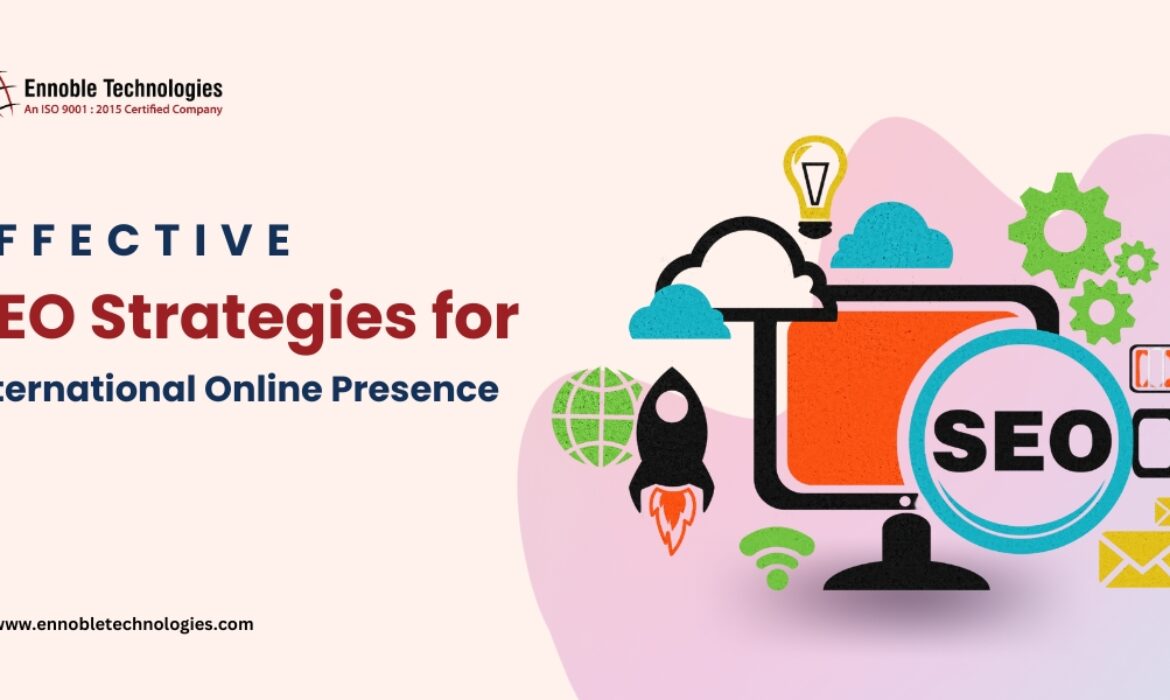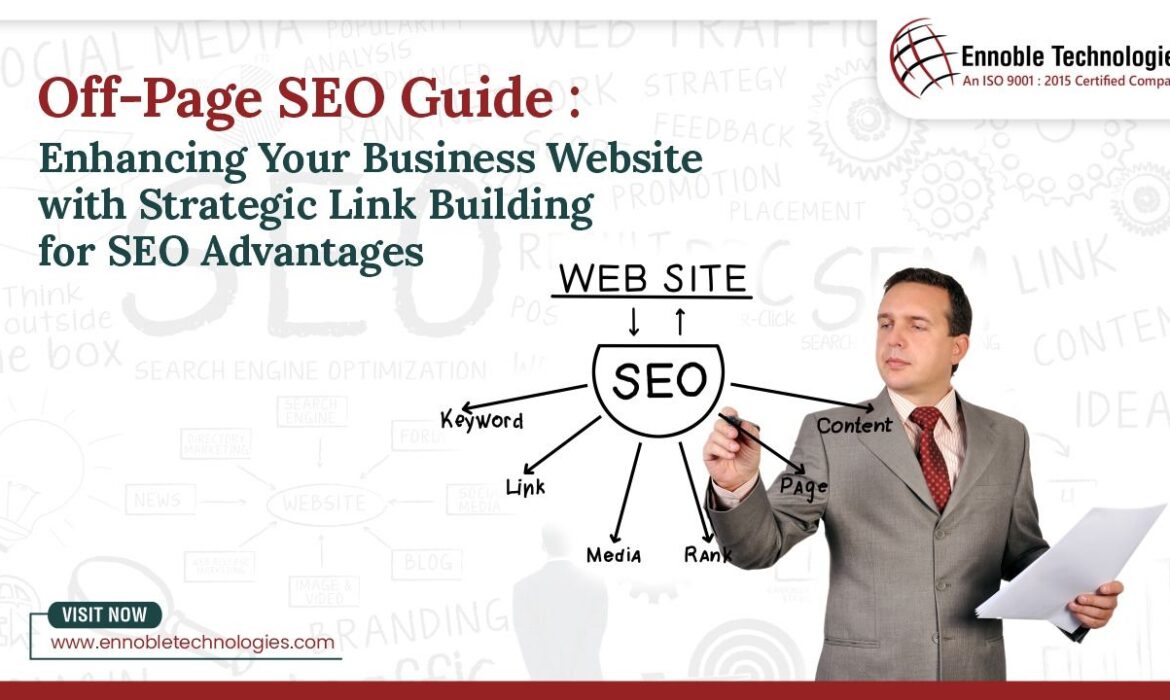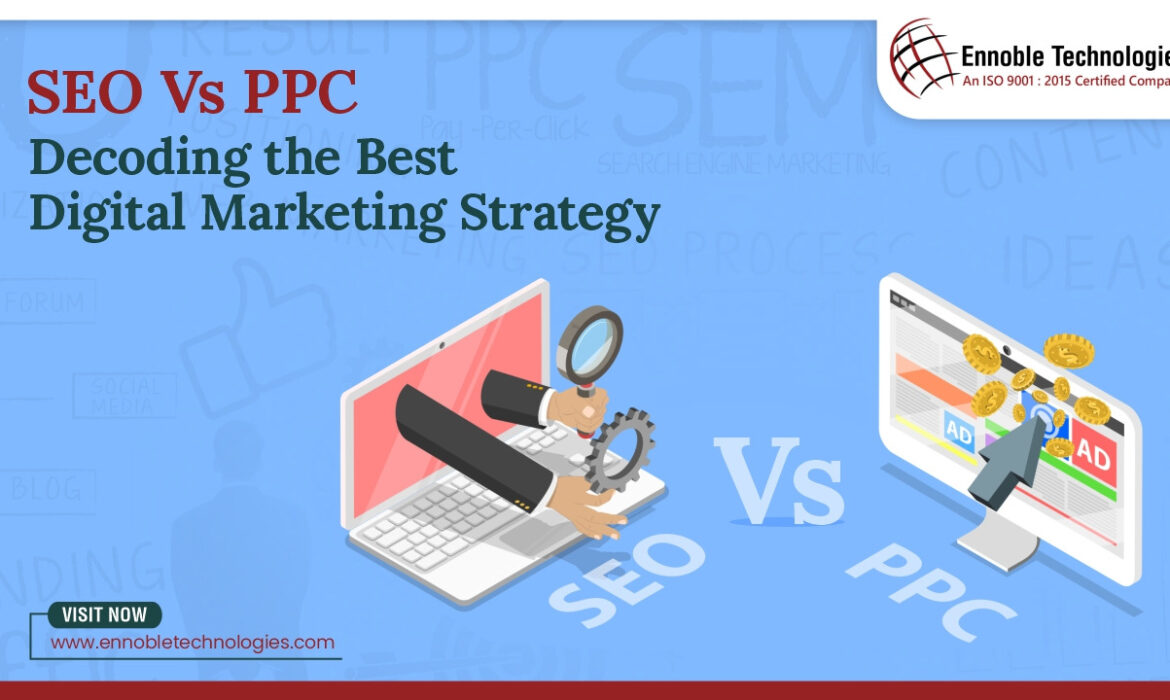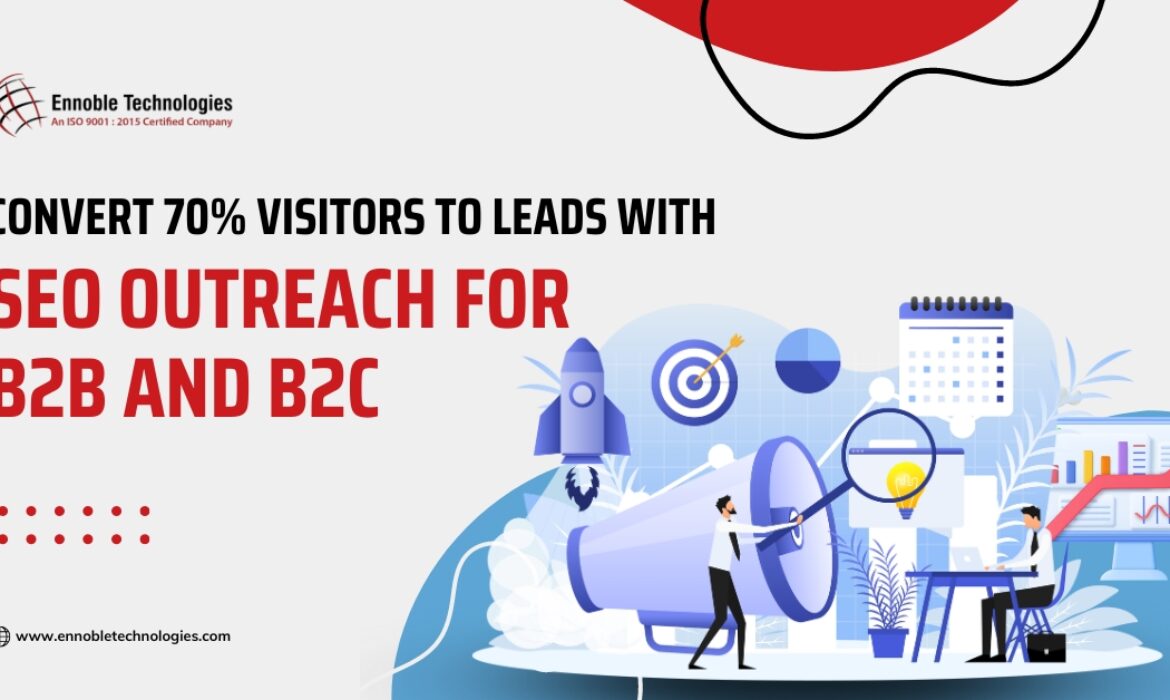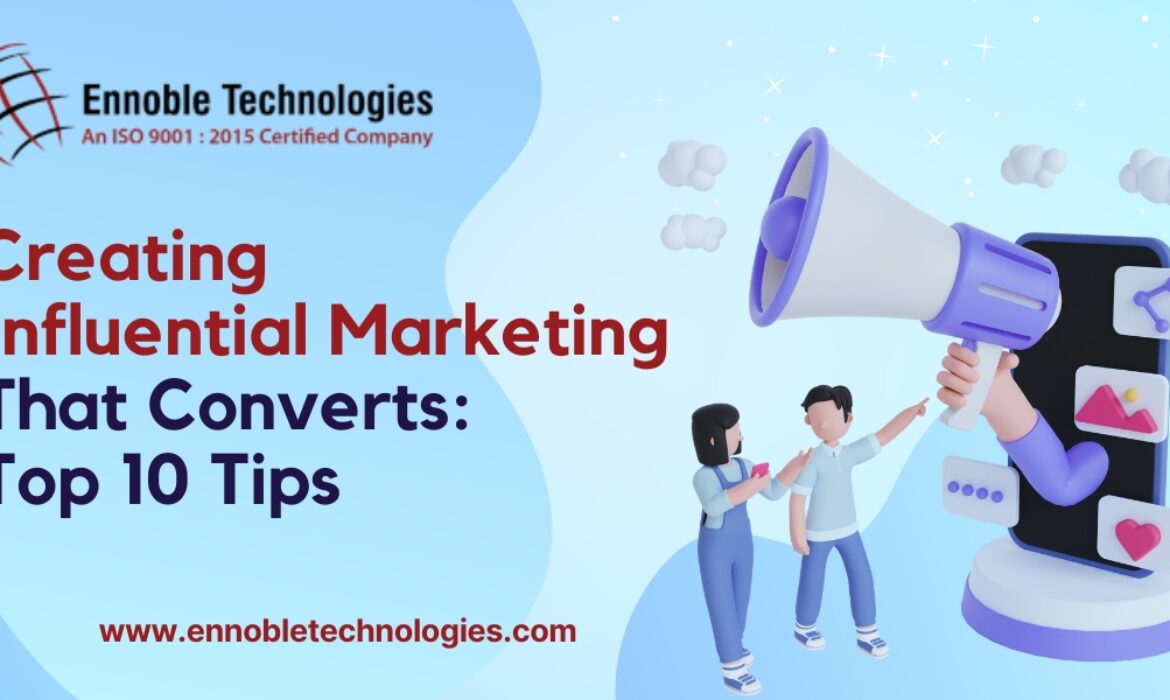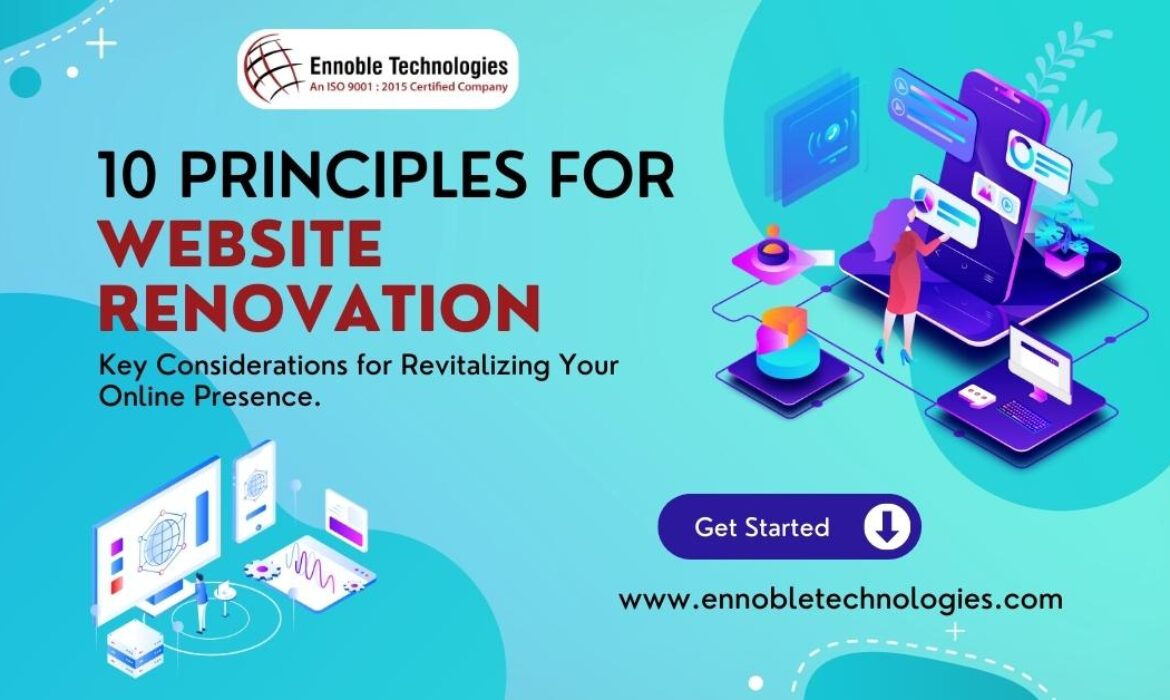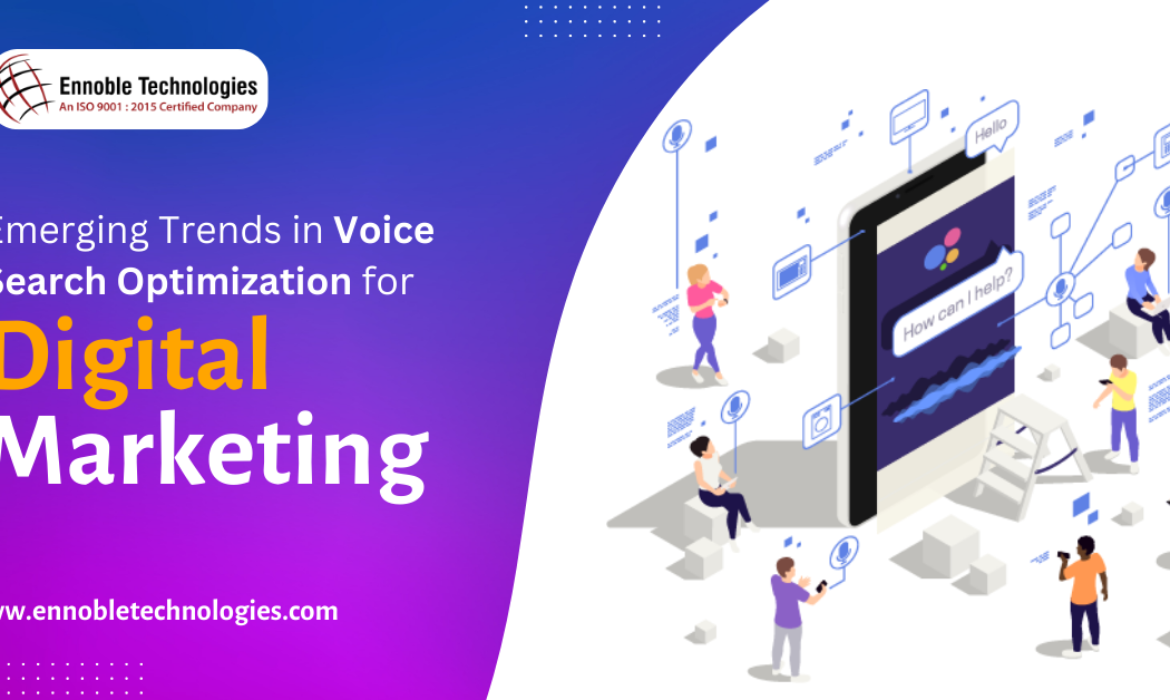Effective SEO Strategies for International Online Presence
In today’s interconnected world, businesses are no longer confined to their local markets. To thrive, companies must expand their reach to international audiences. Effective SEO strategies play a crucial role in achieving a robust online presence across different regions. At Ennoble Technologies, we specialize in providing top-notch global search engine optimization services that cater to diverse cultural and linguistic needs. In this blog, we’ll explore international SEO techniques and SEO best practices to help your business succeed on the global stage.
Understanding the Importance of International SEO
International SEO techniques are essential for businesses aiming to attract and engage customers worldwide. Unlike traditional SEO, which focuses on optimizing a website for a single country or language, global search engine optimization requires a more nuanced approach. This involves adapting your content, keywords, and overall strategy to meet the needs of different regions.
Multilingual SEO Strategies
One of the most important aspects of effective SEO strategies for international markets is the implementation of multilingual SEO strategies. This involves translating and localizing your website’s content to cater to various languages spoken by your target audience. At Ennoble Technologies, we understand the importance of providing accurate and culturally relevant translations to enhance user experience and improve search engine rankings.

Benefits of Multilingual SEO:
- Enhanced User Experience: Offering content in multiple languages makes it easier for users to understand and engage with your website.
- Increased Traffic: By catering to a broader audience, you can attract more visitors from different regions.
- Higher Conversion Rates: When users can access information in their native language, they are more likely to convert into customers.
SEO Best Practices for Different Regions
Implementing SEO best practices for different regions is crucial for the success of your international SEO efforts. Each region has its own unique search behaviors, preferences, and trends. At Ennoble Technologies, we tailor our effective SEO strategies to meet the specific needs of each market.
Key Considerations:
- Keyword Research: Conduct thorough keyword research to identify the most relevant terms for each region. This includes understanding local search intent and preferences.
- Content Localization: Adapt your content to reflect the cultural and linguistic nuances of each region. This goes beyond translation and involves customizing your messaging to resonate with local audiences.
- Technical SEO: Ensure that your website’s technical elements, such as hreflang tags, URL structures, and mobile optimization, are set up correctly for international SEO.
Leveraging SEO Analytics Tools

To measure the success of your effective SEO strategies, it’s essential to utilize SEO analytics tools. These tools provide valuable insights into your website’s performance, user behavior, and search engine rankings across different regions.
Essential SEO Analytics Tools:
- Google Analytics: Track website traffic, user demographics, and conversion rates.
- Google Search Console: Monitor your website’s presence in search results and identify any issues.
- Ahrefs: Analyze backlinks, keyword rankings, and competitor performance.
- SEMrush: Conduct comprehensive keyword research and track your SEO progress.
At Ennoble Technologies, we leverage these tools to provide our clients with data-driven insights and actionable recommendations. This enables us to continuously optimize our global search engine optimization efforts and achieve better results.
Cross-Border SEO Solutions
Expanding your online presence to international markets requires a strategic approach to cross-border SEO solutions. Ennoble Technologies offers a range of services designed to help businesses overcome the challenges of international SEO and achieve their goals.
Our Cross-Border SEO Solutions Include:
- Market Research: Conduct in-depth research to understand the target market’s needs, preferences, and competition.
- Content Strategy: Develop a content strategy that aligns with the cultural and linguistic requirements of each region.
- Link Building: Build high-quality backlinks from reputable websites in different regions to boost your website’s authority.
- Local SEO: Optimize your website for local search engines and directories to improve visibility in specific markets.
Regional SEO Strategies
Implementing regional SEO strategies is vital for businesses looking to establish a strong presence in specific geographic areas. Ennoble Technologies excels in creating customized effective SEO strategies that cater to the unique needs of different regions.
Key Elements of Regional SEO:
- Local Keywords: Identify and target keywords that are specific to the region you are targeting.
- Localized Content: Create content that addresses the interests and concerns of the local audience.
- Local Backlinks: Acquire backlinks from local websites and directories to improve your website’s authority in the region.
- Google My Business: Optimize your Google My Business profile to enhance local search visibility.
Multicultural SEO Services

Catering to a diverse audience requires a deep understanding of cultural differences and preferences. Ennoble Technologies offers multicultural SEO services that help businesses connect with customers from various cultural backgrounds.
Benefits of Multicultural SEO:
- Broader Reach: By appealing to a diverse audience, you can expand your customer base and increase your market share.
- Improved Engagement: Tailoring your content to different cultural preferences enhances user engagement and satisfaction.
- Higher ROI: Effective multicultural SEO can lead to higher conversion rates and better return on investment.
SEO Localization Expertise
SEO localization expertise is essential for businesses looking to optimize their websites for different languages and regions. At Ennoble Technologies, we have a team of experts who specialize in SEO localization to ensure that your content is culturally relevant and search engine-friendly.
Key Aspects of SEO Localization:
- Language Adaptation: Translate and adapt your content to meet the linguistic needs of your target audience.
- Cultural Relevance: Ensure that your content resonates with the cultural norms and preferences of each region.
- Technical Optimization: Implement technical SEO elements, such as hreflang tags and localized URLs, to improve search engine rankings.
Geo-Targeted SEO Solutions
For businesses targeting specific geographic areas, geo-targeted SEO solutions are crucial. Ennoble Technologies offers geo-targeted SEO solutions that help businesses improve their visibility in local search results and attract more customers from specific regions.
Key Components of Geo-Targeted SEO:
- Local Keywords: Identify and target keywords that are relevant to the specific geographic area.
- Local Content: Create content that addresses the needs and interests of the local audience.
- Local Listings: Optimize your website for local directories and listings to enhance local search visibility.
- Google Maps Optimization: Optimize your Google Maps listing to improve local search rankings.
Conclusion
In conclusion, implementing effective SEO strategies is essential for businesses looking to establish a strong international online presence. At Ennoble Technologies, we offer a comprehensive range of global search engine optimization services, including multilingual SEO strategies, cross-border SEO solutions, and geo-targeted SEO solutions. By leveraging our expertise and utilizing advanced SEO analytics tools, we help businesses achieve their international SEO goals and connect with customers worldwide. Whether you are looking to expand your reach to new markets or enhance your visibility in specific regions, Ennoble Technologies has the knowledge and experience to deliver results. Contact us today to learn more about our multicultural SEO services and how we can help your business succeed on the global stage.
Read more: Unlocking Google AdWords PPC Strategies for Success
Off-Page SEO Guide: Enhancing Your Business Website with Strategic Link Building for SEO Advantages
Introduction
In the world of digital marketing, Off-Page SEO plays a critical role in enhancing the visibility and ranking of websites on search engine results pages (SERPs). It focuses on optimizing factors outside the website itself, such as link building and online reputation management. Let’s delve deeper into the realm of Off-Page SEO and discover how strategic link building and other techniques can significantly impact your business’s online presence.
Understanding Off-Page SEO : A Beginner’s Guide
What is Off-Page SEO?
Off-Page SEO refers to optimization efforts that occur outside the boundaries of a website. It involves activities aimed at improving the website’s authority, relevance, and trustworthiness in the eyes of search engines. These efforts are crucial because search engines like Google consider external factors to determine a website’s credibility and rank it accordingly on SERPs.
One of the primary goals of Off-Page SEO is to acquire high-quality backlinks from reputable websites. These backlinks act as votes of confidence for your site, signaling to search engines that other sites trust your content enough to link back to it. As a result, your website’s authority and visibility increase, leading to higher rankings and organic traffic.
Importance of Off-Page SEO:
Off-Page SEO plays a pivotal role in enhancing your website’s visibility and authority on search engines. It focuses on external factors like backlinks, social signals, and brand mentions that contribute to your site’s overall reputation. By implementing effective Off-Page SEO strategies, you can improve your search engine rankings, attract organic traffic, and boost brand credibility.
Difference Between On-Page and Off-Page SEO:
On-Page SEO involves optimizing individual web pages for search engines by optimizing content, meta tags, and internal linking. In contrast, Off-Page SEO focuses on external factors such as backlinks, social media engagement, and online reputation management. While On-Page SEO is about optimizing the structure and content of your website, Off-Page SEO aims to increase your site’s authority and trustworthiness through external signals.
Types of Off-Page SEO Techniques:
a. Link Building: Acquiring quality backlinks from authoritative websites is a fundamental Off-Page SEO technique.
b. Social Media Engagement: Actively engaging with your audience on social media platforms can boost brand visibility and generate social signals.
c. Content Marketing: Creating valuable and shareable content like infographics, videos, and blog posts can attract natural backlinks.
d. Influencer Outreach: Collaborating with influencers can expand your reach and attract relevant traffic to your site.
e. Local SEO: Optimizing your online presence for local searches through local directories and Google My Business is crucial for local businesses.
Importance of Backlinks in SEO: Basics and Benefits
Backlinks are incoming hyperlinks from one webpage to another. They are a fundamental aspect of Off-Page SEO and hold significant weight in search engine algorithms. Search engines view backlinks as endorsements or votes of confidence for a website’s content. The more high-quality backlinks a site has, the more authority and credibility it gains in the eyes of search engines.
There are two main types of backlinks: Dofollow and Nofollow. Dofollow links pass link equity and contribute to a website’s SEO rankings. On the other hand, Nofollow links do not pass link equity but can still drive traffic and improve brand visibility.
Quality backlinks offer several benefits for SEO, including improved search engine rankings, increased organic traffic, enhanced online visibility, and greater trust and authority. However, it’s essential to focus on acquiring natural and relevant backlinks from authoritative sources to maximize these benefits.
Anchor Text Optimization: Beginner to Advanced Techniques
Anchor text plays a crucial role in Off-Page SEO, as it provides context and relevance to the linked content. Optimizing anchor text involves using relevant keywords or phrases that accurately describe the linked page’s content. This optimization helps search engines understand the content’s topic and improves the linked page’s ranking for those keywords.
Beginners can start by using descriptive anchor text that clearly indicates what the linked page is about. As you advance, consider using variations of anchor text, including exact match, partial match, branded, and generic anchor text. Diversifying anchor text types and incorporating long-tail keywords can enhance link relevance and improve SEO performance.
Directory Submissions Demystified: Step-by-Step Guide
Directory submissions are a common Off-Page SEO technique used to improve website visibility and generate backlinks. Directories are online platforms that categorize and list websites based on their niche or industry. Submitting your website to relevant directories can enhance its online presence and attract potential visitors and customers.
To submit your website to directories effectively, follow these steps:
- Research and identify reputable directories in your industry.
- Ensure your website meets the directory’s submission guidelines.
- Create a compelling and informative listing for your website.
- Submit your website to the selected directories, providing accurate and up-to-date information.
- Regularly monitor and update your directory listings to maintain accuracy and relevance.
By following this step-by-step guide, you can leverage directory submissions to boost your website’s visibility and attract valuable traffic.
Unlocking Off-Page SEO: Mastering Strategic Link Building for Business Growth

In today’s competitive digital landscape, Off-Page SEO plays a pivotal role in enhancing your website’s visibility and driving organic traffic. As businesses strive to optimize their online presence, understanding the nuances of Off-Page SEO becomes imperative. In this comprehensive guide, we delve into key Off-Page SEO strategies, including guest blogging, social bookmarking, harnessing social signals, influencer marketing, and PR outreach.
Guest Blogging Essentials: How to Get Started
Guest blogging is a powerful Off-Page SEO technique that not only helps in acquiring backlinks but also establishes your authority in your industry. By contributing valuable content to reputable websites, you can reach a wider audience and drive targeted traffic to your site. Here’s how to kickstart your guest blogging journey.
Introduction to Guest Blogging and its Benefits for SEO
Guest blogging involves writing and publishing content on other websites as a guest contributor. It offers several benefits for SEO, including building backlinks, increasing brand exposure, and improving search engine rankings.
How to Find Guest Blogging Opportunities in Your Niche
Start by researching websites in your niche that accept guest posts. Use search engines and social media platforms to identify potential opportunities. Look for websites with a strong domain authority and engaged audience.
Tips for Writing a Successful Guest Blog Post and Outreach Strategies
When crafting your guest blog post, focus on providing valuable, informative content that resonates with the target audience of the hosting site. Personalize your outreach emails to site owners, highlighting the value you can offer through your guest post.
Social Bookmarking Strategies: Tips for Success
Social bookmarking is another effective Off-Page SEO strategy that involves bookmarking your website or content on social bookmarking platforms. Here’s how to leverage social bookmarking for SEO benefits.
Explanation of Social Bookmarking and its Relevance in SEO
Social bookmarking platforms allow users to save, organize, and share web pages. These platforms have high domain authority, making them ideal for creating backlinks and improving website visibility.
Benefits of Social Bookmarking for Improving Website Visibility
Social bookmarking helps in generating backlinks, driving referral traffic, and increasing online visibility. It also enhances your website’s authority and credibility in the eyes of search engines.
Tips and Strategies for Effective Social Bookmarking
Choose relevant and popular social bookmarking platforms to share your content. Optimize your bookmarks with catchy titles, descriptions, and relevant keywords. Engage with other users’ bookmarks and participate in relevant communities to maximize your reach.
Harnessing Social Signals for SEO: Beginner’s Overview

Social signals refer to the metrics related to social media engagement, such as likes, shares, comments, and social media mentions. These signals can influence search engine rankings and online visibility. Here’s how to harness social signals for SEO success:
Understanding Social Signals and their Impact on Search Rankings
Social signals indicate the popularity and relevance of your content on social media platforms. Search engines consider social signals as a measure of user engagement and content quality, which can impact search rankings.
Importance of Social Signals in SEO and How They are Measured
Social signals contribute to building brand authority, driving traffic, and improving search engine visibility. Metrics like social shares, likes, comments, and follower growth are used to measure social signals’ effectiveness.
Strategies to Increase Social Signals and Monitor their Effectiveness
Create shareable and engaging content that encourages social media interactions. Use social media analytics tools to track social signals and monitor the performance of your social media campaigns. Encourage audience participation and interaction to boost social signals.
Influencer Marketing for Link Building: Getting Started Guide
Influencer marketing involves collaborating with influential individuals in your industry to promote your brand, products, or services. This strategy not only helps in building backlinks but also expands your reach and credibility. Here’s how to leverage influencer marketing for link building.
Introduction to Influencer Marketing and its Benefits for SEO
Influencer marketing allows you to tap into the existing audience of influencers and leverage their authority and credibility to promote your brand. It can result in quality backlinks, increased brand awareness, and improved search engine rankings.
How to Find and Engage with Influencers in Your Industry
Identify relevant influencers in your niche using social media platforms, influencer marketing tools, and industry directories. Build relationships with influencers by engaging with their content, offering value, and showcasing mutual benefits.
Collaborating with Influencers for Link Building and Measuring ROI
Collaborate with influencers on content creation, guest blogging, product reviews, or sponsored campaigns that include backlinks to your website. Track the performance of influencer collaborations using metrics like referral traffic, backlinks, conversions, and ROI.
PR Outreach and Press Releases: Best Practices
PR outreach and press releases are traditional yet effective Off-Page SEO tactics for gaining media coverage, building brand authority, and acquiring backlinks from reputable sources. Here’s how to execute PR outreach and press releases strategically:
Importance of PR Outreach in SEO
PR outreach helps in creating brand buzz, securing media coverage, and earning high-quality backlinks from authoritative sources. It enhances brand visibility, credibility, and trust among target audiences and search engines.
How to Write an Effective Press Release for Maximum Impact
Craft compelling press releases that are newsworthy, timely, and relevant to your target audience. Include relevant keywords, quotes, multimedia elements, and a strong call-to-action (CTA). Distribute press releases to reputable media outlets, journalists, and industry influencers.
Strategies for PR Outreach and Leveraging Press Releases for Link Building
Build relationships with journalists, bloggers, and media professionals through personalized outreach. Offer exclusive content, insights, or interviews to attract media attention. Monitor press coverage, track backlinks, and measure the impact of PR campaigns on SEO performance.
By implementing these Off-Page SEO strategies effectively, businesses can enhance their online visibility, improve search engine rankings, and drive organic traffic to their websites. Incorporate these actionable tips and best practices into your digital marketing efforts to optimize Off-Page SEO and achieve long-term success in the digital landscape.
Forum Engagement for SEO: Tips and Tricks
Engaging in forums can significantly boost your off-page SEO efforts. By actively participating in relevant forums within your industry, you can enhance your brand visibility and establish authority in your niche.
When choosing forums to engage with, prioritize those that are highly relevant to your business. Look for active communities where discussions align with your expertise and target audience.
To make the most out of forum engagement, focus on providing valuable insights and solutions to discussions. Avoid spammy or promotional posts, as these can harm your reputation and credibility.
Building rapport with other forum members is key. Respond to queries, share your knowledge, and engage in meaningful conversations to showcase your expertise.
By consistently contributing valuable content and engaging with others, you can gradually build a positive reputation and attract organic traffic to your website through forum links.
Creating Link-Worthy Infographics: Basics for Beginners

Infographics are powerful tools for link building and content marketing. They combine visual appeal with informational content, making them highly shareable and link-worthy.
When designing infographics, focus on topics that resonate with your target audience and address common pain points or interests. Use compelling visuals, statistics, and key takeaways to make your infographic informative and engaging.
To attract backlinks, consider outreach strategies such as sharing your infographic with industry influencers, bloggers, and websites that publish relevant content. Provide them with a brief summary and encourage them to link back to your infographic when they use it in their content.
Promote your infographics across social media platforms, email newsletters, and other channels to maximize exposure. Encourage sharing and make it easy for others to embed your infographic on their websites.
By creating link-worthy infographics and promoting them effectively, you can earn valuable backlinks, improve your website’s online visibility, and enhance your SEO efforts.
Building Natural Links through Relationships: Strategies for Success
Building strong relationships is essential for acquiring natural backlinks and enhancing SEO performance. Start by identifying key influencers, bloggers, and industry experts within your niche.
Networking events, conferences, and online communities are great places to connect with potential link partners. Engage with them genuinely, offer value, and show interest in their work to build meaningful relationships.
Collaborate on content projects, guest blog posts, or joint ventures to create mutually beneficial opportunities for link building. By leveraging each other’s audiences and expertise, you can attract natural backlinks and improve your search engine rankings.
Maintain regular communication with your link partners and continue to nurture relationships over time. Monitor link placements, track performance metrics, and adapt your strategies based on data insights to optimize your off-page SEO efforts.
Competitor Backlink Analysis: Tools and Insights
Analyzing your competitors’ backlinks can provide valuable insights for enhancing your own link building strategy. Start by identifying your main competitors and using SEO tools to analyze their backlink profiles.
Look for patterns in their backlink sources, anchor text usage, and link quality. Identify high-authority websites that link to your competitors, and explore opportunities to acquire similar backlinks for your site.
Utilize backlink analysis tools to assess the authority and relevance of competitor backlinks. Focus on acquiring backlinks from reputable websites within your industry to improve your own search engine rankings.
Extract insights from competitor backlinks to identify gaps and opportunities in your link building strategy. Tailor your outreach efforts, content creation, and promotional tactics based on competitive analysis to stay ahead in SEO.
Essential Off-Page SEO Tools: Must-Have Resources
Using the right tools is crucial for optimizing your off-page SEO efforts. Top off-page SEO tools offer a range of features for link building, keyword research, backlink analysis, and performance tracking.
Invest in tools that provide comprehensive link building insights, such as backlink quality assessment, competitor analysis, and link tracking capabilities. These tools help you identify link opportunities, monitor progress, and optimize your off-page SEO strategy.
Keyword research tools are essential for identifying relevant keywords, analyzing search volume, and uncovering SEO opportunities. Use backlink analysis tools to assess your backlink profile, track new links, and monitor link quality over time.
Reporting and analytics tools are critical for measuring off-page SEO success. Track key performance indicators (KPIs) like backlink growth, referral traffic, social signals, and conversion rates to evaluate the effectiveness of your SEO efforts.
Measuring Off-Page SEO Success: Key Metrics to Track
To measure the success of your off-page SEO efforts, track key metrics that reflect link building, social signals, and online visibility. These metrics provide valuable insights into your SEO performance and areas for improvement.
Key performance indicators (KPIs) for off-page SEO include:
- Backlink Quality: Monitor the quality and relevance of your backlinks, focusing on authoritative and diverse link sources.
- Social Signals: Track engagement metrics like likes, shares, comments, and mentions on social media platforms to gauge audience interaction.
- Referral Traffic: Analyze traffic from external sources to measure the impact of link building efforts on website visits.
- Conversion Rates: Measure the percentage of visitors who complete desired actions, such as signing up for newsletters or making purchases.
Using data-driven insights from these metrics, optimize your off-page SEO strategies for improved search engine rankings and online visibility.
On a final note:
Mastering off-page SEO is essential for enhancing your website’s rankings, driving organic traffic, and improving online visibility. By implementing strategic link building, leveraging digital marketing techniques, and monitoring key metrics, you can achieve SEO advantages and business growth. Follow the strategies discussed in the guide to boost your off-page SEO results and achieve online visibility optimization.
Read more: https://ennoblegrp.com/seo/mobile-optimization-for-on-page-seo/
PPC and SEO: Decoding the Best Digital Marketing Strategy
Introduction to PPC and SEO
PPC and SEO are two fundamental digital marketing strategies. PPC involves paying for ads to appear at the top of search engine results or on social media platforms, providing immediate visibility and targeted traffic. In contrast, SEO focuses on optimizing a website to rank higher in organic search results through high-quality content, technical improvements, and backlinks, ensuring sustainable and long-term traffic growth. Together, PPC and SEO complement each other by offering both instant results and a lasting online presence, making them essential for a comprehensive digital marketing approach.
What is PPC (Pay-Per-Click)?

PPC, or Pay-Per-Click, is a digital advertising model where advertisers pay a fee each time their ad is clicked. Essentially, it’s a way to buy visits to your site, driving targeted traffic quickly and efficiently.
How It Works:
- Advertising Platforms: The most popular PPC platforms are Google Ads, Bing Ads, Facebook Ads, and LinkedIn Ads. Each platform has its own unique set of features, audience targeting options, and ad formats.
- Keyword Bidding: Advertisers bid on specific keywords related to their products or services. When users search for these keywords, the ads may appear on the search engine results pages (SERPs) or within the chosen platform.
- Ad Placement: Depending on the platform, ads can appear in various formats and locations. For example, Google Ads can display text ads above organic search results, while Facebook Ads might show image or video ads within a user’s feed.
- Cost Structure: PPC operates on a bidding system where the cost per click (CPC) can vary greatly depending on keyword competitiveness, industry, and ad quality. Advertisers can set daily or monthly budgets to control their spending.
- Ad Types: There are several types of PPC ads, including search ads (text-based), display ads (banner images), shopping ads (product listings), and video ads. Each type serves different purposes and can be tailored to specific marketing goals.
PPC is particularly effective for businesses looking to achieve quick results and drive immediate traffic to their websites. It’s an excellent strategy for promotions, product launches, and gaining visibility in competitive markets.
What is SEO (Search Engine Optimization)?

SEO, or Search Engine Optimization, is the practice of enhancing your website to improve its visibility in organic search engine results. Unlike PPC, SEO focuses on earning traffic rather than paying for it, making it a cost-effective strategy in the long run.
How It Works:
- Keyword Research: The foundation of SEO is understanding what terms and phrases your potential customers use to find products or services similar to yours. Tools like Google Keyword Planner, SEMrush, and Ahrefs can help identify valuable keywords.
- On-Page SEO: This involves optimizing individual pages on your website. Key elements include integrating target keywords into your content, crafting compelling meta descriptions, using header tags (H1, H2, etc.), and ensuring images have descriptive alt text.
- Technical SEO: Ensuring your website is technically sound is crucial for SEO success. This includes optimizing site speed, ensuring mobile-friendliness, creating a clean URL structure, and submitting sitemaps for proper indexing by search engines.
- Content Creation: High-quality, relevant content is king in the world of SEO. Regularly publishing informative and engaging blog posts, articles, and other content types can attract and retain visitors, while also signaling to search engines that your site is active and valuable.
- Link Building: Acquiring backlinks from reputable websites helps to build your site’s authority. Techniques include guest blogging, creating shareable infographics, and developing relationships with industry influencers.
- User Experience (UX): SEO isn’t just about search engines; it’s also about providing a great experience for your users. A well-designed, easy-to-navigate site can reduce bounce rates and increase the time visitors spend on your site, both of which are positive signals to search engines.
SEO is a long-term strategy that requires patience and continuous effort. However, the payoff can be substantial, with a steady stream of free, organic traffic to your site and a stronger online presence.
Summary and Transition to Comparison
Now that we’ve detailed the fundamentals of both PPC and SEO, let’s transition into comparing these two powerful digital marketing strategies. Each has its own strengths and is suited to different goals and situations. Whether you’re looking for quick, measurable results or aiming to build a robust, long-term presence, understanding the nuances of PPC and SEO will help you make informed decisions for your marketing efforts.
Shall we dive into a detailed comparison of their benefits, drawbacks, and best-use scenarios?
Detailed Comparison of PPC and SEO

Now that we have a thorough understanding of what PPC (Pay-Per-Click) and SEO (Search Engine Optimization) entail, let’s dive into a detailed comparison to help you determine which strategy might be best for your needs.
Speed of Results
PPC: Immediate Impact
- PPC campaigns can be set up quickly, and ads can start driving traffic almost immediately after launch.
- Ideal for businesses needing rapid results, such as during a product launch or a time-sensitive promotion.
SEO: Long-Term Growth
- SEO takes time to show results, often several months of consistent effort.
- Suitable for businesses aiming for sustained, long-term growth and building a robust online presence.
Cost Considerations
PPC: Controlled but Ongoing Costs
- PPC requires an ongoing investment. You pay each time someone clicks on your ad, with costs varying based on keyword competitiveness and bid amounts.
- Allows precise budget control, but costs can add up, especially in competitive industries.
SEO: Upfront Effort, Lower Long-Term Costs
- SEO involves significant upfront effort in optimizing the site and creating content. However, once your site starts ranking well, the traffic is essentially free.
- Long-term investment with potentially high ROI, but requires patience and continuous optimization.
Traffic Sustainability
PPC: Temporary Boost
- PPC provides a temporary boost in traffic. Once you stop paying for ads, the traffic stops.
- Best for short-term campaigns or when immediate visibility is crucial.
SEO: Sustainable and Evergreen
- SEO efforts lead to sustainable traffic growth. High-ranking content can continue to attract visitors for months or even years without additional costs.
- Great for building long-term authority and consistent traffic flow.
Trust and Credibility
PPC: Perceived as Ads
- PPC ads are often clearly marked as advertisements, which some users may distrust or ignore.
- Effective for visibility but may not always build long-term trust.
SEO: Earned Credibility
- SEO results are seen as more credible and trustworthy by users since they are earned through relevance and quality.
- Enhances your brand’s authority and trustworthiness over time.
Targeting and Customization
PPC: Precise Targeting
- PPC allows detailed targeting options, including demographics, geographic locations, time of day, and even user behaviors.
- Perfect for highly targeted campaigns aiming to reach specific audiences.
SEO: Broad Targeting
- SEO targets users based on search intent and relevant content. It’s less precise than PPC but can attract a wider audience looking for information.
- Effective for capturing broad interest and various stages of the buyer’s journey.
Measurement and Analytics
PPC: Detailed Metrics
- PPC provides extensive analytics, including click-through rates (CTR), conversion rates, cost per click (CPC), and return on ad spend (ROAS).
- Facilitates precise measurement and adjustment of campaigns for optimal performance.
SEO: Complex Metrics
- SEO analytics include organic traffic, keyword rankings, bounce rates, and time on site. Tools like Google Analytics and Search Console provide insights.
- Measuring SEO performance is more complex and involves tracking multiple metrics over time.
Adaptability and Flexibility
PPC: Quick Adjustments
- PPC campaigns can be quickly adjusted in response to performance data or market changes.
- Highly flexible, allowing for rapid testing of different ads and strategies.
SEO: Slow Adaptation
- SEO changes, such as updating content or building new links, take time to reflect in search rankings.
- Requires a more strategic and patient approach to adapt to changes in search algorithms and user behavior.
Use Case Scenarios
When to Use PPC:
- Launching a new product or service and needing immediate visibility.
- Running time-sensitive promotions or sales.
- Targeting specific demographics with precise ads.
- Testing market response quickly.
When to Use SEO:
- Building a long-term, sustainable online presence.
- Enhancing brand credibility and authority.
- Targeting a broad audience at various stages of the buying cycle.
- Investing in a cost-effective strategy with high ROI over time.
PPC (Pay-Per-Click)
Advantages:
Immediate Results: PPC can generate traffic as soon as your ads go live.
Targeted Advertising: You can target specific demographics, locations, and even times of the day.
Control Over Budget: You can set a specific budget and only pay when someone clicks on your ad.
Measurable Results: PPC platforms provide detailed analytics on ad performance.
Brand Visibility: PPC ads appear at the top of search results, enhancing brand visibility.
Disadvantages:
Cost: Can be expensive, especially for competitive keywords.
Temporary: Traffic stops when you stop paying for ads.
Ad Blindness: Some users ignore ads, focusing instead on organic search results.
Continuous Management: Requires ongoing management and optimization to remain effective.
SEO (Search Engine Optimization)
Advantages:
Cost-Effective: Organic traffic is free once your site ranks well.
Sustainable Results: SEO efforts can lead to long-term traffic growth.
Credibility and Trust: Organic search results are often perceived as more trustworthy.
Increased Click-Through Rates (CTR): Higher CTR compared to PPC ads.
Improves User Experience: SEO focuses on creating high-quality content and a better user experience.
Disadvantages:
Time-Consuming: Takes time to see results, often several months.
Algorithm Changes: Search engines frequently update their algorithms, which can affect rankings.
Complexity: SEO requires a deep understanding of search engine algorithms and ranking factors.
Ongoing Effort: Continuous effort and updates are needed to maintain and improve rankings.
Key Differences
- Speed: PPC provides immediate results, while SEO is a long-term strategy.
- Cost: PPC requires ongoing investment, while SEO involves upfront effort but can yield long-term free traffic.
- Sustainability: SEO provides sustainable traffic, while PPC requires constant spending.
- Trust and Credibility: SEO tends to build more trust with users compared to PPC.
- Targeting: PPC allows precise targeting options, whereas SEO targets are based on keyword optimization and content relevance.
Let’s delve deeper into how to integrate PPC and SEO effectively to maximize your digital marketing efforts.
Integrating PPC and SEO
Combining PPC and SEO strategies can create a powerful synergy, enhancing your overall online presence and driving more significant results. Here’s how you can effectively integrate both approaches:

1. Keyword Strategy
Unified Keyword Research:
- Conduct comprehensive keyword research to identify high-performing keywords for both PPC and SEO.
- Use tools like Google Keyword Planner, Ahrefs, and SEMrush to find keywords that have high search volumes and relevance to your business.
- Identify overlapping keywords that can be targeted in both PPC campaigns and SEO content.
Complementary Keywords:
- Use PPC data to discover high-converting keywords that might not yet rank well organically.
- Optimize your SEO content for these high-performing PPC keywords to gradually improve organic rankings.
- Utilize long-tail keywords in SEO that may be too expensive to target with PPC.
2. Content Marketing
Content Creation:
- Develop high-quality, engaging content based on your keyword research. This content can serve both SEO and PPC purposes.
- Create blog posts, articles, videos, and infographics that address the needs and interests of your target audience.
- Use PPC to promote your content and drive immediate traffic, while simultaneously working on organic rankings.
Landing Pages:
- Design landing pages optimized for both PPC conversions and SEO. Ensure they are relevant to the ad copy and keywords used in your PPC campaigns.
- A/B test different landing pages to determine which performs best in terms of conversions and user engagement.
- Optimize these pages for SEO by incorporating target keywords, meta descriptions, and quality content.
3. Data Sharing and Insights
Performance Analytics:
- Share data between your PPC and SEO teams to gain comprehensive insights into which strategies are working best.
- Use PPC data to identify which keywords and ad copies generate the most conversions, then apply these insights to your SEO strategy.
- Analyze SEO performance to understand which keywords and content pieces drive the most organic traffic, and consider incorporating these into your PPC campaigns.
Conversion Tracking:
- Implement conversion tracking for both PPC and SEO efforts to measure the effectiveness of each strategy.
- Use tools like Google Analytics, Google Ads, and other marketing platforms to track user behavior, conversions, and ROI.
- Compare conversion data to understand the customer journey and how PPC and SEO contribute to different stages of the funnel.
4. Brand Visibility and Credibility
Enhanced Brand Presence:
- Use PPC to gain immediate visibility at the top of search engine results while your SEO efforts build up.
- Having both paid ads and organic listings appear on the same SERP can increase brand credibility and capture more real estate.
- This dual presence can improve click-through rates (CTR) and provide a more robust online presence.
Reinforcing Messaging:
- Ensure your PPC ads and SEO content deliver consistent messaging and branding.
- Use similar headlines, value propositions, and calls-to-action (CTAs) across both channels to reinforce your brand message.
- This consistency helps build trust and recognition among your audience.
5. Local Search Optimization
Local SEO and PPC:
- For businesses targeting local customers, integrate local SEO practices with PPC campaigns.
- Optimize your Google My Business listing and use local keywords in your SEO content.
- Run location-based PPC ads to attract local traffic and increase visibility in your target areas.
Practical Steps to Integrate PPC and SEO
- Regular Meetings and Collaboration:
- Schedule regular meetings between your PPC and SEO teams to discuss strategies, share insights, and align goals.
- Foster a collaborative environment where both teams work together to enhance overall performance.
- Unified Reporting:
- Create unified reports that include metrics from both PPC and SEO campaigns. This helps in understanding the bigger picture and making informed decisions.
- Use these reports to identify opportunities for improvement and areas where integration can be enhanced.
- Consistent Optimization:
- Continuously optimize both PPC and SEO efforts based on performance data. Adjust bids, ad copies, and keywords for PPC, and update content, meta tags, and technical aspects for SEO.
- Stay updated with algorithm changes and industry trends to keep both strategies effective and relevant.
On a final note:
By integrating PPC and SEO, you can leverage the strengths of both strategies to achieve comprehensive digital marketing success. This approach not only maximizes your reach and visibility but also ensures that you capture and convert traffic at every stage of the customer journey. Regular collaboration, data sharing, and consistent optimization are key to creating a harmonious and effective marketing strategy.
Read more : https://ennoblegrp.com/social-media/power-of-youtube-marketing/
Unlocking SEO Success: 8 Key Insights to Enhance Your Optimization Strategy for Your Business Website
1. Optimize for Featured Snippets
Understanding Featured Snippets: A Primer for SEO Success
To achieve SEO success, it’s crucial to understand the significance of featured snippets in search engine results. Featured snippets occupy the top position in search results and mastering them can significantly enhance your website’s visibility and organic traffic. By focusing on providing concise, direct answers to common questions related to your business or industry, you can optimize your content for the coveted featured snippet spot, ultimately contributing to your SEO success.
Cracking the Code: Strategies to Optimize for Featured Snippets
In the quest for SEO success, it’s essential to crack the code of featured snippets by identifying high-opportunity keywords and structuring your content to provide relevant and comprehensive answers. Crafting content that aligns with the types of featured snippets, such as paragraphs, lists, or tables, can increase the likelihood of your content being selected for the coveted position. Employing schema markup and optimizing for voice search are additional strategies to enhance your SEO success in featured snippet optimization.
Targeting Position Zero: Tips for Featured Snippet Optimization
Targeting position zero, the coveted spot for featured snippets, requires a proactive approach to content optimization. By conducting thorough keyword research and analyzing existing featured snippets for your target keywords, you can identify opportunities to create content that stands out. Crafting compelling, informative content that directly addresses user queries can position your website as a valuable resource and increase the likelihood of earning featured snippet placements, ultimately contributing to your SEO success.
2. Implement Advanced Schema Markup

Harnessing Advanced Schema Markup for Enhanced SEO
In the pursuit of SEO success, harnessing advanced schema markup is paramount. Advanced schema markup allows websites to provide search engines with detailed information about their content, resulting in enhanced visibility and higher click-through rates. By implementing advanced schema markup strategies, websites can improve their chances of appearing in rich results and featured snippets, ultimately contributing to their SEO success.
Unleashing the Power of Schema Markup: Advanced Strategies
Unleashing the power of schema markup involves advanced strategies that go beyond the basics. By incorporating advanced schema markup techniques such as product markup, FAQ schema, and how-to schema, websites can provide search engines with valuable context about their content, leading to improved visibility and higher search engine rankings. Implementing these advanced strategies is essential for achieving SEO success in today’s competitive digital landscape.
Elevating Your SEO Game with Advanced Schema Implementation
Elevating your SEO game requires advanced schema implementation to stand out in search engine results. By utilizing advanced schema markup, websites can enhance their search listings with rich snippets, knowledge panels, and other rich results, ultimately leading to increased organic traffic and improved SEO success. Advanced schema implementation is a game-changer for websites looking to maximize their visibility and impact in search results.
Beyond Basics: Advanced Techniques for Schema Markup Optimization
To achieve SEO success, it’s crucial to go beyond the basics and leverage advanced techniques for schema markup optimization. Advanced schema markup optimization involves detailed structuring of data to provide search engines with comprehensive information about web content, ultimately leading to improved relevance and visibility in search results. Embracing these advanced techniques is essential for websites aiming to achieve SEO success through schema markup optimization.
3. Enhancing Core Web Vitals for Seamless User Experience
Core Web Vitals Demystified: Enhancing User Experience for SEO
In the world of SEO, understanding and optimizing Core Web Vitals is crucial for achieving SEO success. These key metrics, including loading performance, interactivity, and visual stability, directly impact user experience and search engine rankings. By prioritizing Core Web Vitals, website owners can enhance the overall user experience, leading to improved SEO performance.
Mastering Core Web Vitals: Techniques for SEO Success
To achieve SEO success, mastering Core Web Vitals is essential. Techniques such as optimizing server response times, minimizing render-blocking resources, and leveraging browser caching can significantly improve these vital metrics. By focusing on Core Web Vitals, website owners can ensure that their sites provide a seamless and engaging user experience, ultimately leading to better search engine visibility.
Speed Matters: Optimizing Loading Times for Better Web Vitals
One of the most critical aspects of Core Web Vitals is loading performance. Optimizing loading times through techniques such as image optimization, code minification, and content delivery network (CDN) implementation can greatly enhance Web Vitals and contribute to SEO success. By prioritizing speed and performance, website owners can create a more favorable environment for both users and search engines.
The Importance of Core Web Vitals in SEO: Best Practices
When it comes to SEO success, understanding the importance of Core Web Vitals is paramount. Implementing best practices such as reducing first input delay, optimizing cumulative layout shift, and prioritizing largest contentful paint can significantly improve overall Web Vitals. By focusing on these best practices, website owners can ensure that their sites meet the necessary criteria for optimal user experience and search engine performance.
4. Understanding the Power of Topic Clusters and Pillar Pages

Unleashing SEO Potential: Harnessing Topic Clusters and Pillar Pages
Unlock the true potential of SEO success by harnessing the power of topic clusters and pillar pages. By organizing your content around these strategic structures, you can enhance your website’s visibility and authority in search engine results.
Strategic Content Architecture: Leveraging Topic Clusters for SEO Success
Crafting a strategic content architecture that leverages topic clusters is essential for achieving SEO success. By organizing related content into clusters and linking them to a pillar page, you can signal to search engines the relevance and depth of your expertise, driving improved rankings and visibility.
Building Authority: How Pillar Pages Drive SEO Performance
Pillar pages play a pivotal role in building authority and driving SEO performance. By serving as comprehensive guides to broad topics and linking to related cluster content, pillar pages demonstrate your website’s expertise and relevance, leading to enhanced search engine rankings and visibility.
Connecting the Dots: Creating Topic Clusters for Improved SEO
Creating topic clusters is crucial for connecting the dots and improving SEO performance. By grouping related content around a central theme and interlinking them strategically, you can signal to search engines the depth and breadth of your content, resulting in improved visibility and rankings.
Topic Clusters Unveiled: A Comprehensive Guide to SEO Strategy
Unveil the power of topic clusters as a comprehensive SEO strategy. By organizing your content into clusters and establishing clear topic authority, you can enhance your website’s relevance and visibility in search engine results, driving SEO success.
5. Optimizing for Voice Search: Embracing Future Trends for Enhanced SEO Performance
Voice Search Optimization: Paving the Way for Future SEO Success
In the ever-evolving landscape of SEO, voice search optimization has emerged as a pivotal factor for future success. As voice search continues to gain prominence, adapting your SEO strategy to accommodate this trend is crucial for staying ahead of the competition. By focusing on voice search optimization, you can pave the way for sustained SEO success in the rapidly changing digital environment.
The Rise of Voice Search: Strategies to Stay Ahead in SEO
With the rise of voice search, it’s imperative to implement strategies that keep your SEO efforts ahead of the curve. Understanding the shift towards voice-based queries and tailoring your content to align with conversational search patterns are essential steps in ensuring continued SEO success. By acknowledging the rise of voice search and proactively optimizing your content, you can position your website for sustained visibility and success in search engine rankings.
Unlocking Voice Search Potential: Tips for SEO Optimization
Unlocking the potential of voice search requires strategic SEO optimization geared towards accommodating natural language queries. By incorporating long-tail keywords and structuring your content to provide direct, concise answers, you can enhance your website’s visibility and authority in voice search results. Optimizing for voice search presents a valuable opportunity to fortify your SEO success and connect with a broader audience through conversational interactions.
Voice Search SEO: Adapting Your Strategy for Changing Trends
Adapting your SEO strategy to encompass voice search is essential for maintaining relevance amidst changing search trends. Embracing voice search SEO involves aligning your content with the nuances of spoken queries and focusing on contextually relevant responses. By acknowledging and adapting to changing search trends, you can position your website for sustained SEO success in the era of voice-driven interactions.
6. Achieving SEO Success through Video Optimization: Engage, Educate, and Elevate

Lights, Camera, Action: The Role of Video Optimization in SEO Success
In the competitive landscape of online visibility, video optimization plays a pivotal role in achieving SEO success. Incorporating video content into your SEO strategy can significantly enhance your website’s visibility and authority, ultimately leading to increased traffic and higher rankings on search engine result pages.
Unlocking Potential: Strategies for Effective Video SEO
To unlock the full potential of video content for SEO success, it is crucial to implement strategic video SEO techniques. By optimizing video titles, descriptions, and tags with relevant keywords, you can improve your content’s discoverability and relevance, thus driving SEO success through enhanced visibility and engagement.
From Content to Conversion: Maximizing ROI with Video Optimization
Maximizing ROI through video optimization involves not only creating compelling and relevant video content, but also ensuring that it is effectively optimized for search engines. By aligning video content with user intent and leveraging call-to-action overlays and annotations, you can drive conversions and achieve SEO success through increased user engagement and action.
7. Enhance E-A-T for Credible and Authoritative Websites
Understanding E-A-T: Building Blocks of Credibility in SEO
In the realm of SEO success, understanding E-A-T (Expertise, Authoritativeness, Trustworthiness) is fundamental. E-A-T serves as the cornerstone for building credibility and trust with both users and search engines. By comprehending and implementing E-A-T principles, websites can lay a solid foundation for achieving SEO success.
Elevating Authority: Strategies to Enhance E-A-T for SEO
Elevating authority through strategic implementation of E-A-T principles is paramount for SEO success. By showcasing expertise, establishing authoritativeness, and building trustworthiness, websites can enhance their E-A-T signals, thereby boosting their credibility and visibility in search engine results. Elevating authority through E-A-T strategies is a crucial step towards long-term SEO success.
Trust Matters: Optimizing E-A-T for Website Credibility
In the context of SEO success, trust matters significantly, and optimizing E-A-T is essential for establishing website credibility. By focusing on transparency, user-centric content, and authoritative backlinks, websites can strengthen their E-A-T factors, ultimately enhancing their trustworthiness and credibility in the eyes of search engines and users.
The Role of Expertise: Establishing Authority in Your Niche
Establishing expertise plays a pivotal role in achieving authority within your niche for SEO success. By demonstrating in-depth knowledge, industry leadership, and valuable insights, websites can position themselves as authoritative sources, thereby strengthening their E-A-T signals and paving the way for SEO success.
Authoritativeness in Action: Techniques to Boost E-A-T Signals
Taking action to boost authoritativeness through effective E-A-T techniques is crucial for SEO success. By delivering high-quality, well-researched content, showcasing industry accolades, and earning endorsements from reputable sources, websites can actively enhance their authoritativeness, thereby solidifying their position in search engine rankings.
8. Unlock SEO Success with AI and Machine Learning Tools: Enhancing Your Strategy

AI and Machine Learning in SEO: A Game-Changer for SEO Success
In the ever-evolving landscape of SEO, AI and machine learning are proving to be a game-changer for achieving SEO success. By leveraging advanced algorithms and data-driven insights, AI technologies empower businesses to make informed decisions and stay ahead of the competition. Embracing AI and machine learning in SEO strategies is crucial for staying competitive and achieving long-term SEO success.
Leveraging AI: Transforming Your SEO Strategy for SEO Success
Leveraging AI in your SEO strategy can significantly impact your SEO success. AI-powered tools can analyze large sets of data, identify patterns, and make real-time adjustments to optimize your website’s performance. By harnessing the power of AI, businesses can enhance their SEO strategies and drive sustainable SEO success in a dynamic digital landscape.
The Power of Data: Enhancing Insights with AI and Machine Learning for SEO Success
Harnessing the power of data through AI and machine learning can provide invaluable insights for achieving SEO success. By utilizing sophisticated algorithms to interpret data trends and user behavior, businesses can gain a deeper understanding of their target audience and tailor their SEO strategies accordingly. The integration of AI and machine learning in SEO empowers businesses to make data-driven decisions, ultimately leading to improved SEO success.
Read more: https://ennoblegrp.com/seo/seo-outreach-for-b2b-and-b2c/
Convert 70% visitors to leads with SEO Outreach for B2B and B2C
Introduction:
Imagine turning 70% of website visitors into engaged leads, simply by implementing the right SEO outreach strategies. Sounds impossible? It’s not – and we’ll show you how in this blog. In the dynamic realm of digital marketing, search engine optimization (SEO) outreach plays a pivotal role in both Business-to-Business (B2B) and Business-to-Consumer (B2C) sectors. This comprehensive guide explores the distinctive roles and significance of SEO outreach in driving visibility, credibility, and engagement for businesses targeting diverse audiences and markets.
—————————————————————————————————————————————————————–
What is B2B SEO?
B2B SEO involves optimizing your website and online presence to attract qualified business leads through organic search, leveraging targeted content and strategic outreach to cater to longer sales cycles and complex decision-making processes.
—————————————————————————————————————————————————————–
SEO Outreach in B2B Digital Marketing
In the competitive landscape of B2B digital marketing, SEO outreach stands out as a critical component for driving organic visibility, establishing authority, and generating high-quality leads. By implementing targeted outreach b2b strategies, building meaningful relationships, and continuously optimizing their approach, B2B marketers can unlock new opportunities for growth, differentiation, and success in their respective industries.
B2B Blogger Outreach Strategies: Building Authority and Relationships
Beyond standard Search engine optimization tactics, B2B outreach thrives on building genuine connections with bloggers and industry influencers. Here are key strategies to leverage:
1. Guest Blogging:
- Target relevant publications: Identify industry blogs, thought leader platforms, and online communities frequented by your target audience.
- Pitch valuable content: Offer unique insights, data-driven reports, or industry analyses relevant to their readers.
- Personalize your outreach: Don’t use generic templates. Research the editor’s interests and tailor your pitch to their specific audience.
- Build relationships: Don’t just see it as a one-time opportunity. Interact with their content, offer additional insights, and build long-term connections.
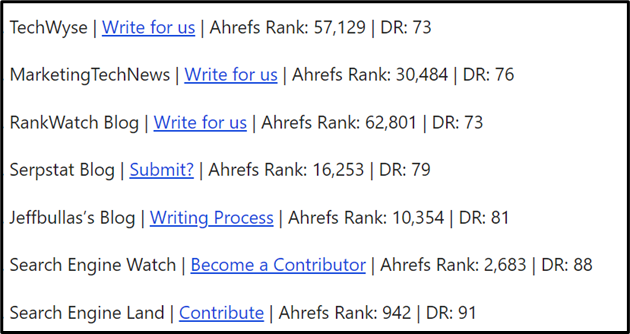
2. Influencer Marketing:
- Identify key influencers: Partner with industry experts, thought leaders, or niche bloggers who resonate with your target audience.
- Collaborate on valuable content: Co-create white papers, webinars, or podcasts addressing industry challenges and showcasing your expertise.
- Leverage their reach: Utilize their established audience to amplify your message and build brand awareness.
- Nurture authentic partnerships: Treat them as valued partners, not just marketing tools. Offer mutual benefits and respect their influence.
3. Create Shareable Content:
- Industry insights with a twist: Go beyond dry reports. Infographics, data visualizations, or interactive tools make complex information engaging.
- Problem-solving content: Address common pain points your target audience faces and offer practical solutions through blog posts, case studies, or guides.
- Leverage social media: Optimize content for different platforms and encourage sharing with relevant hashtags and calls to action.
- Run targeted contests: Partner with relevant bloggers to incentivize content creation and social sharing around your brand or industry topic.

Source: buffer.com
—————————————————————————————————————————————————————–
How to Craft an SEO outreach strategy for B2B success:
Build relationships, leverage data, and create targeted content that resonates with decision-makers.
—————————————————————————————————————————————————————–
SEO Outreach in B2C Digital Marketing
Conversely, in the B2C realm, Search engine optimization outreach serves as a catalyst for engaging with individual consumers, driving brand awareness, and facilitating seamless interactions across diverse consumer segments. Key considerations and B2C SEO strategies for effective search engine optimization outreach in B2C digital marketing include Consumer-Centric Keyword Optimization, User-Centric Content Creation, E-commerce and Local Search engine optimization, Social Media Integration and Influencer Collaboration.

B2C Blogger Outreach Strategies: Engaging Communities and Sparking Conversation
B2C outreach thrives on emotional connection and captivating content. Here are key strategies to spark engagement and build brand love:
1. Interactive Experiences:
- Run contests and giveaways: Partner with relevant bloggers to host product giveaways, photo contests, or user-generated content challenges. This incentivizes interaction and brand awareness.
- Livestream events: Partner with micro-influencers for Q&A sessions, product demonstrations, or behind-the-scenes glimpses. Build a sense of community and excitement.
- Interactive quizzes and polls: Engage audiences with fun quizzes about your products or industry trends. Offer personalized discounts or recommendations based on results.

2. User-Generated Content (UGC):
- Encourage user-generated content: Partner with micro-influencers to create authentic product reviews, tutorials, or lifestyle content featuring your brand.
- Host hashtag campaigns: Encourage user-generated content with branded hashtags and incentives. Showcase the best submissions on your website and social media.
- Run UGC contests: Encourage photo or video submissions showcasing their experience with your brand. Reward creativity and offer exciting prizes.
3. Leverage Social Media Communities:
- Join relevant communities: Engage in discussions, answer questions, and offer valuable insights within relevant online communities and forums. Build trust and brand recognition.
- Partner with community leaders: Collaborate with community moderators or influential members to host AMAs, product demos, or exclusive events. Reach a targeted audience within a trusted space.
- Run community-specific promotions: Offer exclusive discounts or contests targeted towards specific online communities to incentivize engagement and brand loyalty.
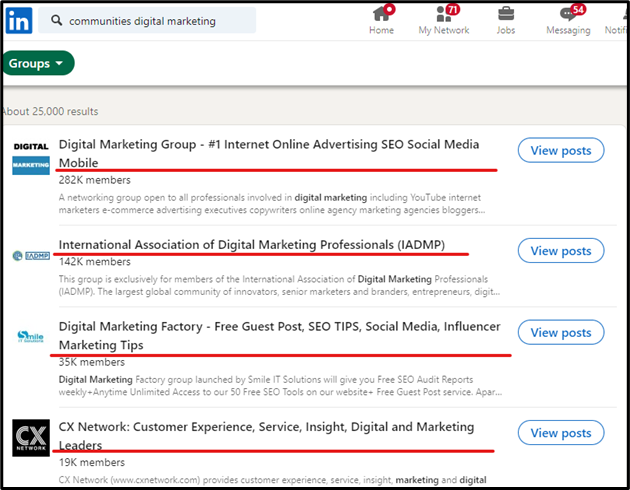
—————————————————————————————————————————————————————–
What is B2C SEO?
B2C SEO optimizes your online presence to attract individual consumers through search engines. Think engaging content, strategic keywords, and mobile-friendliness – all crafted to drive website visits and convert them into customers.
—————————————————————————————————————————————————————–
Common Principles and Best Practices
While the nuances of SEO outreach in B2B and B2C digital marketing are distinct, several common principles and best practices underpin the effectiveness of SEO outreach in both domains, including Content Quality and Relevance, User Experience and Mobile Optimization, Performance Monitoring and Data-Driven Optimization, Adaptation to Search Engine Algorithms and Trends.
Mastering the Double Play: B2B vs. B2C SEO Outreach in 2024
While both aim to build authority and attract leads, B2B and B2C SEO outreach strategies differ due to their unique target audiences and buying journeys. Here’s a quick breakdown:
| Feature | B2B | B2C |
| Target Audience | Decision-makers, businesses | Individual consumers |
| Sales Cycle | Longer, more complex | Shorter, impulse-driven |
| Focus | Building relationships, industry expertise | Brand awareness, emotional connection |
| Platforms | Industry publications, professional networks | Social media, influencer marketing |
| Content | White papers, case studies | Engaging visuals, interactive formats |
| Metrics | Domain authority, backlinks | Brand mentions, social engagement |
Current Trends in SEO Outreach:
Navigating the Ever-Evolving Landscape of SEO Outreach: Expert Insights from 10 Years in the Trenches
Gone are the days of generic, spray-and-pray outreach emails. Today’s SEO landscape demands a sophisticated, data-driven, and personalized approach that builds genuine relationships and resonates with your target audience. Here’s what I’ve learned in my 10-year journey, exploring the key trends shaping the future of SEO outreach:
1. Personalization is King (and Queen):
Forget mass blasting – it’s time to craft messages tailored to individual influencers and their audiences. Consider:
- Researching: Dive deep into their content, interests, and values to find common ground.
- Segmenting: Group influencers by niche, demographics, and engagement levels for targeted pitches.
- Hyper-personalizing: Use dynamic variables to address them by name and reference specific content they’ve created.
The ROI: A study by Yesware found that personalized emails have a 14% higher open rate and a 6% higher reply rate than generic ones.
Real-world example: Buzzsumo, a content marketing platform, saw a 300% increase in outreach success by personalizing pitches with relevant data about influencers’ past shares.
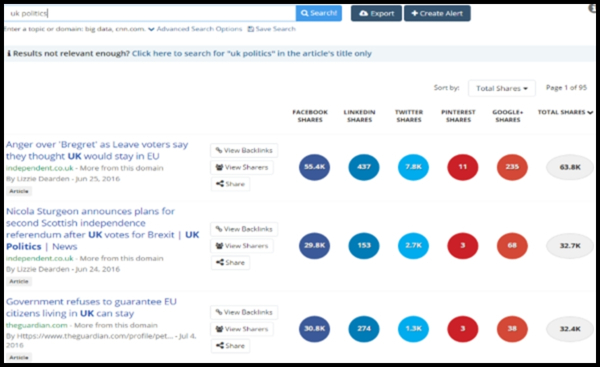
2. Data Drives Decisions:
Don’t gamble on gut feeling, leverage data to identify high-potential targets and track campaign performance. Tools like:
- Buzzsumo: Analyze trending topics and identify relevant influencers.
- Ahrefs: Track competitor backlinks and discover potential outreach partners.
- Google Analytics: Measure traffic sources and identify influencers driving valuable visits.
The stat: Marketing Charts reports that 87% of marketers leverage data analytics to identify marketing opportunities.
Real-world example: SEMrush, a SEO software company, used data to identify relevant podcasts, secured guest appearances, and saw a 40% increase in organic traffic.
3. New Platforms Emerge:
Expand your reach beyond traditional blogs and websites. Consider:
- Podcasts: Guest appearances on relevant podcasts can tap into engaged audiences and build brand authority.
- Social media communities: Engaging with niche groups on platforms like Reddit and Discord fosters meaningful connections and brand advocacy.
- Live video platforms: Platforms like Twitch and YouTube Live offer interactive opportunities to connect with audiences in real-time.
The potential: Social media influencer marketing is expected to reach a $16.4 billion industry by 2025.
Real-world example: Dollar Shave Club partnered with micro-influencers on Instagram, reaching a targeted audience and achieving a 25% increase in sales.
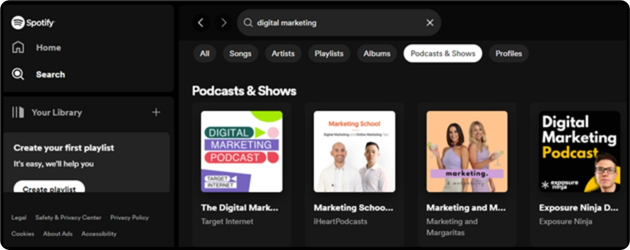
4. Micro-Influencers Make a Mark:
Forget celebrity endorsements, micro-influencers (10k-50k followers) offer higher engagement rates and authentic reach. They:
- Possess specific expertise and resonate with niche audiences.
- Foster trust and connection, making their recommendations more impactful.
- Offer better value for your outreach budget compared to big-name influencers.
The stat: Influencer marketing platform AspireIQ found that micro-influencers generate 6 times more engagement per follower than mega-influencers.
Real-world example: Eos Lip Balm partnered with micro-influencers in the beauty niche, resulting in a 400% increase in website traffic and a 20% rise in sales.
5. Voice Search Optimization:
With voice assistants like Siri and Alexa becoming increasingly popular, optimizing your outreach Search engine optimization strategy for voice search is crucial. Consider:
- Long-tail keywords: Focus on natural language phrases people use in voice searches.
- Structured data: Implement schema markup to improve voice search rankings.
- Content clarity: Create concise and informative content that answers specific questions.
The fact: Gartner predicts that 30% of all web searches will be conducted without a screen by 2020.
Real-world example: The Home Depot optimized its website for voice search, resulting in a 20% increase in voice-driven mobile conversions.
6. Content & Outreach Hand-in-Hand:
Your outreach efforts thrive when backed by high-quality content that resonates with your target audience. Integrate:
- Blog posts: Offer valuable insights and data relevant to influencers’ and their audiences’ interests.
- Infographics and visual content: Grab attention and simplify complex information for better engagement.
- Interactive tools and quizzes: Create experiences that encourage participation and generate data for future outreach.
The synergy: A study by Content Marketing Institute revealed that companies with blogs generate 55% more leads than those without.
Real-world example: Buffer, a social media management platform, created engaging infographics and secured backlinks from high-authority websites
—————————————————————————————————————————————————————–
Ennoble excelling at SEO Outreach for clients!
With 7+ years of digital marketing mastery, Ennoble Technologies crafts powerful B2B SEO strategies & B2C SEO outreach campaigns. Our team, led by a 10+year SEO veteran, delivers results that fuel your growth. Uncover the latest trends and proven SEO strategies to engage your audience and dominate the online space. Partner with Ennoble and turn website visitors into loyal customers today!
—————————————————————————————————————————————————————–
B2B Outreach: Mastering the Complex Game – Leveraging 10 Years of Expertise
B2B outreach is a different beast compared to its B2C counterpart. Longer sales cycles, complex decision-making processes, and the need for trust-building require a strategic and nuanced approach. Here, I’ll draw on my 10 years of experience to equip you with powerful B2B outreach best practices:
Understanding the Key Differences:
- Decision-Making: B2B purchases involve multiple stakeholders with diverse needs and concerns. Understand your target company’s buying journey and identify key decision-makers.
- Relationships Matter: Building genuine connections with individuals, not just titles, is crucial. Focus on providing value, not just pitching your product.
- Content is King: Offer insightful content like white papers, case studies, and industry reports that address specific pain points and showcase your expertise.
Actionable Tips for Success:
1. Research is King:
- Target the right companies: Use tools like ZoomInfo or LeadGenius to identify ideal prospects aligned with your solution.
- Know your decision-makers: Research their backgrounds, interests, and challenges to personalize your outreach.
- Understand their industry: Stay updated on industry trends and challenges to position your message for relevance.
2. Personalization is Key:
- Craft email introductions by name: Avoid generic templates and mention something specific about their work or interests.
- Offer tailored solutions: Highlight how your product/service addresses their unique needs and challenges.
- Go beyond email: Consider personalized LinkedIn messages, thought leadership pieces, or even handwritten notes for high-value targets.
3. Leverage Industry Events and Networks:
- Participate in relevant conferences and trade shows: Network with potential partners and decision-makers.
- Join industry associations and online communities: Build relationships and establish your expertise through thought leadership.
- Speak at industry events: Showcase your knowledge and gain credibility within the target audience.
4. Cultivate Relationships with Media and Influencers:
- Identify journalists and publications covering your industry: Build relationships by offering valuable insights and data.
- Contribute guest articles or industry reports: Gain exposure and establish your brand as a thought leader.
- Partner with relevant influencers: Leverage their reach and credibility to connect with key decision-makers.
5. Data & Analytics: Your Guiding Light:
- Track key metrics: Monitor open rates, click-through rates, and website traffic generated from your outreach efforts.
- Identify what’s working and what’s not: A/B test different subject lines, messaging strategies, and content formats.
- Refine your approach: Use data to continuously improve your outreach campaigns and maximize ROI.
Real-World Success Stories:
Case Study: A B2B SaaS company identified key decision-makers at target companies through LinkedIn research. By sending personalized emails with relevant case studies, they secured a 30% meeting acceptance rate.
Industry Example: A marketing agency built relationships with industry journalists by offering unique data and insights. They secured several media placements that generated qualified leads.
Remember, B2B outreach is a marathon, not a sprint. By implementing these best practices and leveraging my 10 years of experience, you can build genuine relationships, create value, and ultimately turn leads into loyal customers for your B2B business.
Cracking the B2C Code: Engaging Outreach B2C Strategies for Today’s Consumers
B2C outreach is a vibrant dance compared to its B2B counterpart. Shorter sales cycles, emotional triggers, and the need to grab attention demand a dynamic and engaging approach.
Leveraging my 10 years of experience, let’s delve into powerful B2C outreach best practices:
Understanding the Key Differences:
- Emotional Connection: Tap into emotions like excitement, joy, or fear to trigger impulsive desires and encourage action.
- Faster Conversions: B2C purchases often happen quickly, so ensure your outreach is clear, concise, and easily leads to conversion.
- Content is King, But Engagement is Queen: Go beyond informative content; create interactive experiences, user-generated content, and shareable moments.
Actionable Tips for Captivating Your Audience:
1. Master the Social Media Game:
- Engage with your audience: Respond to comments, participate in conversations, and run polls to foster a sense of community.
- Leverage influencer marketing: Partner with relevant micro-influencers who resonate with your target audience for authentic reach.
- Run contests and giveaways: Generate excitement and incentivize user interaction with appealing prizes.
2. Create Content that Sizzles:
- Focus on visuals: Utilize captivating images, videos, and infographics that grab attention and tell a story.
- Go interactive: Implement quizzes, polls, and augmented reality experiences to boost engagement.
- Optimize for mobile: Ensure your content displays flawlessly and is easily consumable on smartphones and tablets.
3. Personalization Matters, Even in the Crowd:
- Segment your audience: Create targeted campaigns based on demographics, interests, and past behavior.
- Use dynamic personalization tools: Address individuals by name and tailor messaging based on their preferences.
- Offer exclusive deals and promotions: Reward loyal customers and incentivize repeat purchases.
4. Data & Analytics: Your Performance Compass:
- Track key metrics: Monitor engagement rates, click-through rates, and conversion rates across different platforms and campaigns.
- Run A/B tests: Experiment with different headlines, images, and calls to action to see what resonates best.
- Refine your approach: Use data to continuously improve your outreach efforts and maximize ROI.
Real-World Success Stories:
Case Study: A clothing brand partnered with micro-influencers in the fashion niche. User-generated content featuring the brand led to a 20% increase in website traffic and a 15% rise in sales.
Industry Example: A food delivery app ran a social media campaign with a personalized quiz to recommend dishes. This interactive experience boosted engagement by 30% and generated valuable customer data.
Remember, B2C outreach is about creating a connection and a conversation. By implementing these best practices and leveraging my 10 years of experience, you can reach your target audience, captivate their attention, and ultimately convert them into loyal brand advocates.
Top SEO Outreach Tools:
Crafting a successful SEO outreach campaign requires the right tools to identify targets, personalize emails, and track results. Here’s a list of top options, both free and paid, categorized by their function:
| Category | Tool (Free) | Tool (Paid) |
| Target Identification | ||
| Buzzsumo | Semrush, SpyFu, Majestic, Similarweb Pro | |
| Ahrefs Backlink Checker | Buzzsumo Pro, Buzzstream | |
| Google Search Console | LinkMiner, BuzzStream Sumo | |
| Social Mention | Ahrefs Content Explorer, SE Ranking | |
| HARO | Pitchbox Guestlist, Traackr | |
| AnswerThePublic | Buzzsumo Influencers, Followerwonk | |
| Reddit Keyword Search | Pitchbox Alerts, Brand24 | |
| Quora Topic Search | Followerwonk Pro, Mention | |
| Email Personalization | ||
| Gmail Merge | Mailshake, Pitchbox, Voila Norbert | |
| Hunter | Respona, Pitchbox Email Finder | |
| MailChimp (up to 2,000 contacts) | Snov.io, ContactOut | |
| Streak for Gmail | Outreach.io, Saleshandy | |
| Boomerang for Gmail | Klout, Buzzsumo Influencers | |
| Content Creation & Tracking | ||
| Canva | Buzzsumo Sumo, Buffer, Similarweb Pro | |
| Google Analytics | Buzzsumo Pro, Pitchbox Insights | |
| Piktochart | Visme, Lumen5 | |
| Unsplash | Freepik, Storyblocks | |
| Animoto | InVideo, Wideo | |
| Google Trends | SEMrush Content Assistant, Ahrefs Content Ideas | |
| Relationship Building | ||
| LinkedIn, Twitter, HARO | Pitchbox Guestlist, Brand24, Buzzsumo Influencers | |
| Facebook Groups | Followerwonk Pro, Traackr | |
| Reddit Communities | Buzzstream, LinkMiner | |
| Quora Spaces | Ahrefs Alerts, SEMrush Brand Monitoring | |
| Discord Servers | Pitchbox Community, Buzzsumo Connect | |
| Online Events & Webinars | Traackr Discover, Buzzsumo Events | |
| Podcast Appearances | Podchaser, Matchmaker.fm |
Unlock the Power of Blogger Outreach: Turn Social Likes into Leads!
- Facebook:
Turn likes into leads! Unlock powerful B2B & B2C blogger outreach strategies & convert 70% of website visitors with free & paid tools. Get the insider tips in our blog! #SEO #leadgeneration #searchengineoptimization - Instagram:
Convert clicks to customers! Discover killer B2B & B2C blogger outreach hacks & skyrocket your lead generation with free & paid tools. Link in bio! #SEOtips #businessgrowth - LinkedIn:
Boost your sales funnel! Learn 70% conversion secrets via B2B & B2C blogger outreach & power up your lead generation with free & paid tools. Read our blog now! #B2Bmarketing #C2Cmarketing
—————————————————————————————————————————————————————–
Interesting fact – Did you know?
The average salary for an SEO outreach specialist in the United States is over $70,000 per year.
—————————————————————————————————————————————————————–
FAQs about SEO outreach specialists
Q. What skills do I need to be an SEO outreach specialist?
A. You will need strong communication and writing skills, as well as a good understanding of Search engine optimization and content marketing. You should also be able to use data analysis tools and be comfortable building relationships with people online.
Q. What is the career outlook for SEO outreach specialists?
A. The career outlook for Search engine optimization outreach specialists is very positive. The demand for SEO professionals is expected to grow in the coming years, as businesses increasingly recognize the importance of online marketing.
Q. How can I get started as an SEO outreach specialist?
A. There are a number of ways to get started as an SEO outreach specialist. You can take online courses or attend workshops to learn the skills you need. You can also start by building your own website or blog and practicing your outreach skills by trying to get backlinks from other websites.
Boost Your SEO with Influencer Outreach: The Complete Guide to Landing IoT Guest Posts
Targeting an IoT Influencer for a Guest Post Backlink: Step-by-Step Guide
Target: John Doe, Sr. Vice president of MagicCloud
Tools:
- Buzzsumo: Identify influencer’s best guest posts.
- Hunter: Find target’s email address.
- Mailshake: Personalize and send outreach emails.
Steps:
1. Research & Identify:
- Use Buzzsumo to find the influencer’s most popular guest posts on IoT topics.
- Analyze the posts for insights about their preferred content style and audience.
2. Craft a personalized pitch:
Use Hunter to find the influencer’s professional email address (avoid generic info@ emails). Draft a personalized email using Mailshake.
Here’s a sample script:

3. Personalize and Send:
- Use Mailshake’s personalization features to insert the influencer’s name, specific post title, and other relevant details.
- Send the email at an appropriate time, considering their location and time zone.
4. Follow Up:
- If you don’t receive a response within a week, send a courteous follow-up email using Mailshake.
- Be respectful of their time and avoid being pushy.
5. Negotiate & Secure Guest Post:
- If they express interest, discuss the topic, content outline, and desired backlink placement.
- Collaborate on creating a high-quality guest post that benefits both your audiences.
Remember:
- Focus on offering value and building a genuine connection.
- Respect the influencer’s time and expertise.
- Be patient and persistent, but not pushy.
- By following these steps and utilizing the recommended tools, you can increase your chances of securing a valuable backlink on an influential IoT blogger’s website.
Conclusion
In essence, the role of SEO outreach in both B2B and B2C digital marketing is rooted in enhancing online visibility, driving relevant traffic, and fostering meaningful connections with target audiences. By tailoring search engine optimization outreach strategies to the unique dynamics of B2B and B2C markets, organizations can position themselves for sustained success, drive engagement, and achieve business objectives within their respective domains. Whether engaging with businesses or individual consumers, the strategic deployment of search engine optimization outreach remains fundamental to achieving digital marketing success across diverse sectors.
Also Read: Mobile Optimization: Crucial for On-Page SEO Success – Ennoble Technologies
Also Read: On-Page SEO vs. Off-Page SEO: Which Matters More? – Ennoble Technologies
Also Read: Mastering On-Page SEO: Practical Tips & Tricks – Ennoble Technologies
Also Read: 10 On-Page SEO Mistakes You Must Avoid – Ennoble Technologies
SEO Content Writing with AI: Possibilities & Problems Explored
Hello there! In the dynamic world of digital marketing, staying ahead of the competition requires a well-executed SEO strategy. As technology continues to advance, AI-powered content writing tools have emerged as a promising solution for optimizing website content to rank higher in search engine results. These tools harness the power of artificial intelligence to generate SEO-friendly content, promising improved visibility and organic traffic. But like any innovation, AI-powered SEO content writing comes with its own set of possibilities and challenges. In this blog post, we’ll take a friendly dive into the world of AI and explore the potential benefits and complexities of using AI for SEO content creation.
The Possibilities of AI in SEO Content Writing:

1. Enhanced Efficiency:
AI-powered content writing tools can automate various aspects of the content creation process, saving time and effort for marketers and content creators. These tools can generate high-quality content at a faster pace, enabling businesses to scale their content production and meet the demands of an ever-growing digital landscape.
2. Improved Keyword Optimization:
AI algorithms can analyze vast amounts of data and identify patterns in keyword usage. This allows AI-powered content writing tools to suggest relevant keywords and optimize content accordingly. By incorporating these suggestions, businesses can improve their keyword targeting and increase their chances of ranking higher in search engine results.
3. Content Personalization:
AI can analyze user behavior, preferences, and demographic information to create personalized content. By tailoring content to individual users or specific target audiences, businesses can enhance user engagement, increase conversion rates, and build stronger connections with their audience.
4. Language and Grammar Enhancement:
AI-powered content writing tools often come equipped with advanced language processing capabilities. They can identify grammatical errors, suggest improvements, and even generate content that adheres to a specific tone or style. This helps ensure that the content produced is not only optimized for search engines but also of high quality and readability.
The Problems and Challenges of AI in SEO Content Writing:

1. Lack of Contextual Understanding:
AI algorithms may struggle to comprehend the nuances of language, cultural references, or context-specific content requirements. This can result in content that feels robotic or lacks the human touch, potentially impacting user engagement and brand credibility.
2. Originality and Uniqueness:
AI-powered content writing tools can generate text based on existing data and patterns. While this can be efficient, it raises concerns regarding the originality and uniqueness of the content. Plagiarism and duplicate content issues can harm search rankings and damage a brand’s reputation.
3. Ethical Considerations:
The use of AI in content writing raises ethical concerns, such as the potential for biased or misleading content. AI algorithms are trained on existing data, which may contain biases or inaccuracies. It is essential for businesses to maintain ethical practices, review AI-generated content, and ensure compliance with legal and ethical standards.
4. Human Touch and Creativity:
AI may struggle to replicate the creativity, intuition, and emotional connection that human content creators bring to their work. Content that lacks the human touch may fail to resonate with audiences on a deeper level, impacting the overall user experience and brand perception.
Conclusion:
As the digital landscape continues to evolve, AI-powered content writing tools hold immense promise for optimizing SEO strategies and streamlining content creation processes. The possibilities are vast, including enhanced efficiency, improved keyword optimization, personalized experiences, and polished language quality. However, it’s important to navigate the challenges that come with AI, such as the need for contextual understanding, maintaining originality, addressing ethical considerations, and preserving the human element in content creation.
To harness the full potential of AI in SEO content writing, striking a balance between automation and human creativity is crucial. By utilizing AI as a valuable tool and infusing it with the unique insights and touch of human content creators, you can create compelling, engaging, and authentic content that resonates with your audience.
Remember, technology is a powerful ally, but it should never overshadow the importance of human connection and creativity. Embrace the possibilities that AI offers while remaining mindful of its limitations, and you’ll be well-equipped to navigate the ever-evolving landscape of SEO content writing with confidence and success.
Read More: Revolutionizing Marketing: The Future of Artificial Intelligence (AI) – Ennoble Technologies
Creating Influential Marketing That Converts: Top 10 Tips
When you create marketing materials, it’s important to consider what will make them influential. After all, the goal of marketing is to influence the behavior of your target audience. But what exactly is influential marketing?
So, influential marketing is any marketing that has a significant impact on the behavior of its target audience. For example, an ad campaign that convinces people to switch to a new brand of toothpaste is considered influential.
So, how can you create influential marketing that will actually convert? Keep reading for 10 tips that will help you create persuasive and influential marketing materials that will yield results!
What Makes Influential Marketing Different?
What makes influential marketing different from regular marketing is that it not only captures the attention of your audience and generates leads, but also encourages them to take a definitive action. Whether that’s buying your product, signing up for your newsletter, or donating to your cause – influential marketing can be used to drive conversions.
To achieve this, it’s important to understand the psychology behind what drives people to take action. You need to understand the audience’s behavior, values, and motivations. You also need to create content that is tailored specifically toward that audience and is both visually appealing and emotionally resonant.
Another key element of influential marketing is the way it is delivered. Whether through email, social media, or pay-per-click advertising, you need to use the right channels to reach your audience. Your content should also be creative and dynamic, as this will help grab their attention and encourage them to take action.
Why You Should Use Influential Marketing Strategies
It is important for marketers to use influential marketing strategies for a number of reasons. Firstly, it gives brands the opportunity to engage with their target audience in a way that increases customer loyalty and trust. This is especially important in an era where many people are wary of traditional forms of marketing and advertising.
In addition, using influential marketing strategies can help increase conversions and drive sales. By understanding the values and motivations of their target audience, marketers can create content that is both emotionally resonant and visually appealing. This will help engage the audience and inspire them to take action.
Finally, influential marketing strategies can be used to build long-term relationships with customers. By using creative and engaging content that people are likely to share, marketers can create viral campaigns that will reach new potential customers and foster loyalty from existing customers.
What Are the Benefits of Influential Marketing?
Using influential marketing strategies can provide many benefits for marketers, including:
- Increased Reach – Influential marketing can help brands build relationships and reach new potential customers. By creating content that is eye-catching and emotionally resonant, brands can tap into the power of influencers to spread the message.
- Boosted Brand Awareness – Influential marketing helps to increase brand awareness, allowing marketers to reach a wider audience and create a lasting impression. Influential content should have a touch of creativity and originality that makes it stand out from other content.
- Improved Conversion Rates – Influential marketing can help to drive conversions and generate sales. By understanding their target audience and creating content that resonates with their values and motivations, businesses can inspire their audience to take action.
- Improved Customer Engagement – Influential marketing helps to nurture relationships with customers by engaging them in meaningful conversations and creating a positive emotional connection. This will help to build loyalty and trust for the brand.
How to Create Influential Marketing Materials
The success of any influential marketing campaign boils down to its content. Marketers should create content that resonates with their target audience and encourages them to take action. Here are some tips to help you create influential marketing materials:
- Identify Your Ideal Customer – Crafting influential content starts by understanding your target audience and their needs. Identify your ideal customer and create content that is tailored to their interests and values.
- Use Eye-Grabbing Visuals – To create effective influential content, it should be visually appealing. Using eye-catching visuals such as images, infographics, and videos can be more effective than using text alone.
- Leverage Authentic Voices – Online customers trust people more than brands. Leverage influencers and social media users to create content that is authentic and relatable to your target audience.
- Tell Engaging Stories – Stories that evoke emotions help to create a connection with readers and inspire action. Use storytelling to engage your target audience and create persuasive content.
- Ensure Your Content is Shareable – To maximize the reach of your content, it should be easily shareable across platforms. Make sure to add share buttons and optimize your content for social media.
- Analyze Content Performance – Content performance analysis should be an integral part of your influencer marketing strategy. Track metrics such as website visits, click-through rate (CTR), downloads, and shares to measure how your content is performing with your target audience.
- Optimize Content for SEO – Influential marketing content should be optimized for search engines. Use relevant keywords, meta-descriptions, and meta-tags to ensure your content ranks higher in search results.
- Keep Content Fresh – To keep customers engaged, marketers should regularly update content. Publish new blog posts, create new visuals, and share new information from influencers to expand your reach.
- Make Use of AMP Pages –AMP (Accelerated Mobile Pages) can help to boost content performance on mobile devices. Since most customers are accessing content through mobile devices, AMP pages can help marketers reach a wider audience.
- Analyze Content Results – Analyzing the results data of your content is essential. Analyze content reviews, comments, and surveys to measure the impact of your campaign and inform future campaigns.
In a nutshell
The digital marketing landscape is constantly changing. Marketers should invest their time and resources into understanding tech-enabled marketing tools as well as the emerging technologies. Businesses must also ensure their digital marketing teams fully understand the latest advancements and trends to develop successful campaigns.
Furthermore, marketers must be aware of the ever-changing consumer preferences and use the insights gathered from emerging technologies to build relationships with their customers. Data collected from marketing automation tools, predictive analytics, and AI should help businesses gain an understanding of the current market and deploy the best digital marketing tactics.
Our goal at Ennoble Technologies is to identify new opportunities for your business, increase your conversions, and target the right customers for your business growth. Through the right tools and strategies, we use technology to help you grow your business. By leveraging the ever-evolving technology, we stay ahead of the curve as the best digital marketing agency. You now know who to call to keep your business on top!
10 Principles for Website Renovation: Key Considerations for Revitalizing Your Online Presence
Having a website has now become a necessity. It is one of the easy-to-access and powerful leverages that could be used to achieve higher market goals and cut yourself from the competition. Your website shows your online presence, and it’s often where customers first connect with a business or individuals. Whether you own a small business or make a living as a blogger, you must ensure your website is up-to-date and user-friendly. In this article, we’ll discuss 10 principles for website renovation that are key considerations for revitalizing your online presence.
10 Principles to Consider for Website Renovation
A website is certainly a powerful and essential tool that showcases your products, services, or content. However, if it is slow, old, and not friendly, you could lose many potential customers or audiences.
Set Goals
Being specific about your goals helps you define what you want to achieve. It can be related to your website’s design, functionality, user experience, or business objectives. Some examples of rebuilding your website include increasing website traffic, sales, or leads. In addition, they include improving the engagement of users, making it more accessible, or updating website content.
Know Your Audience
You need to know who your majority audience is to understand their needs or expectations. Your website should be designed keeping your target audience in mind to ensure it is engaging, user-friendly, and provides what they need. For example, use vibrant colors and modern design elements if you are targeting young adults.
Create a Responsive Website
Responsive websites adjust to different screen sizes, such as desktops, tablets, and smartphones. Having a responsive website is essential because most people use the internet on mobile devices. And if yours doesn’t fit properly on the users’ screen, it can create problems accessing and reading the content.
Focus on User Experience
User experience (UX) determines whether visitors stay or leave. A website with good UX is easy to use, appears attractive, and doesn’t irritate users. There are various methods, including improving website navigation, using clear and concise language, creating a good menu bar, focusing on relevant images, etc. It would make the platform easy to use and understand.
Conduct a Content Audit
By auditing your content, you can check if it is outdated or irrelevant, and update or remove it. In addition, it helps identify gaps so you can create relevant content accordingly. You can seek help from tools such as Google Analytics to do a content audit. You can check how engaging they are and decide whether they need updating or removing.
Add social media
Social media integration allows visitors to connect with you and share your content on social platforms. However, increasing social signals also improve your website’s SEO. Adding social media icons or embedding social media feeds are some of the best ways to do so. You may include your social profiles in the header or footer to let visitors follow the brand on those platforms.
Optimize for Search Engines
Search engine optimization (SEO) increases website visibility in search engine results pages (SERPs). This is the ultimate way to drive more organic traffic. Some ways are proper keyword research, on-page optimization, link building, and more. It will help you rank well in search engines.
Ensure Security
A powerful security system protects your website and visitors’ personal information from cyberattacks. Eventually, you will be able to build trust and credibility. Some effective practices are using strong passwords, updating software and plugins, implementing HTTPS, and using a web application firewall (WAF).
Improve Site Speed
Site speed affects both user experience and SEO. A slow website can frustrate visitors and increase bounce rates, negatively impacting SEO. To improve site speed, optimize images and code, leverage browser caching, use a content delivery network (CDN), and more.
Check Results and Change the Strategy
Measuring your results will help you know whether your strategy is working. It allows you to make new changes and decisions. Instead of just blindly following, you would be able to identify new growth opportunities. It involves tracking website metrics, analyzing user behavior, and making decisions based on those data.
Conclusion
Renovating your website will improve its design, functionality, and user experience, making it more engaging and accessible to your audience. By following these 10 principles, you can revitalize your online presence and improve your website’s user experience, SEO, security, and performance. In spite of this, you should always monitor your results and make further plans as necessary.
Also Read: Emerging Trends in Voice Search Optimization for Digital Marketers – Ennoble Technologies
Emerging Trends in Voice Search Optimization for Digital Marketers
With the highly increasing demands for smart devices and virtual assistants, voice search has become a useful factor for digital marketers. Voice search optimization is the process of optimizing your website content so it can rank on voice assistants like Siri, Alexa, or Google Assistant. It involves optimizing your content, using natural language processing (NLP), and focusing on long-tail keywords. In today’s article, we will discuss the emerging trends in voice search optimization for digital marketers and how it can help grow your business.
Voice Search and its Popularity
Voice search has grown tremendously in recent years. It is expected to gain more attention in the future. Many suggest that voice search might cover up to 50% of all searches a year or two from now.
However, people prefer using voice search because it is faster, more convenient, and provides a hands-free experience. Additionally, voice search is becoming more accurate and reliable. Soon, it will be an even more attractive option than other forms of searches.
How Voice Search Optimization is Important for Digital Marketers?
Digital marketers need to optimize their content to rank well on voice search. It is an effective way to reach their target audience faster and easier. Optimizing for voice search can help businesses improve their search rankings, increase website traffic, generate leads, and more. Additionally, it can help businesses improve their user experience.
However, optimizing for voice search can be challenging. It requires different methods than the search engine optimization (SEO) we use for websites. Businesses need to focus on conversational language and long-tail keywords. Also, one needs to ensure the content is readable and structured to be easily understood.
Emerging Trends in Voice Search Optimization
Using Natural Language Processing (NLP)
NLP is an AI technology that helps computers understand human language. With voice search, however, we use our conversational language and ask questions as we do with others. NLP helps voice assistants understand these questions and provide relevant answers. You can optimize your content for NLP by using natural language.
Featured Snippets
Featured snippets are brief snippets of text that appear at the top of search engine results pages (SERPs). They provide the answer a user is searching for. Users are more likely to receive answers from featured snippets, making them a crucial part of voice search optimization. You can use featured snippets by providing clear and to-the-point answers to commonly asked questions.
Local Search Optimization
Local search optimization means preparing our content for local search queries. For instance, people ask about nearby businesses, products, or services. Including relevant information about them in our content can help in ranking easily.
Focusing on Long-Tail Keywords
Long-tail keywords are longer, more specific search phrases that generally have lower search volumes but higher conversion rates. Users are more likely to use long-tail keywords as they ask questions briefly and conversationally.
Using Schema Markup
Schema markup is a type of microdata that helps search engines understand the content on a web page. It can help voice assistants by providing more accurate and relevant answers. Digital marketers can optimize their content by using schema markup on their websites.
How to Use Voice Search Optimization?
Here are some key strategies that can help you:
Preparing Content
You need to prepare your content for voice search by using conversational language, targeting specific long-tail keywords, and providing clear and direct answers to frequently asked questions.
Building a Friendly Website
Ensure your website is mobile-friendly, optimize page load speed, and provide structured data using schema markup.
Creating Skills
You can create voice-activated skills for smart devices to increase user interaction. This can include games, quizzes, and other engaging content that makes users feel attached and comfortable with it.
Developing a Plan
You should focus more on keyword research, content creation, and website optimization. You should also monitor your results regularly and come up with new changes as needed.
Conclusion
Voice search optimization can be quite helpful for digital marketers. If someone wants to reach their target audience faster and improve their online visibility, optimizing their content for voice search can help to gain positive results. This can be the way to stay ahead of the competition and provide customers with a better user experience.
However, digital marketers need to keep up with new advancements and make strategies accordingly. They will also need to focus on other areas such as privacy and security measures for users.
Also Read: What are the benefits of link building for SEO? – Ennoble Technologies
What are the benefits of link building for SEO?
Despite its simplicity, link building is a crucial part of SEO. The procedure can be challenging at times. The goal is to lure other websites to link back to yours. The site’s popularity and authority in the desired search engines are prerequisites for realizing this goal.
Google also considers user engagement when determining page rank. So merely a person clicking and exiting won’t do. The time spent on a website also is recorded in the search engine logs, which are also used to determine the genuineness of the website. So, the more visitors who visit your site, the better.
Clearly, there are many upsides to link building, and in this blog post, we will explore them all so you can get a firm grasp on the topic’s genuine importance for search engine optimization.
Improved Search Engine Rankings
One of the most important factors that search engines employ to determine a page’s ranking is the number and quality of inbound links from other similarly high-quality and reputable websites. Search engines place more stock in a website as an authoritative and relevant source of information if it has received links from other credible websites.
One factor determining where a website appears in search engine results is Google’s PageRank algorithm. When establishing a page’s worth and relevance, PageRank considers both the number and quality of inbound connections.
Research shows that websites with more backlinks have a better chance of ranking higher in SERPs. For example, according to a Moz study, websites with high domain authority and high-quality backlinks score higher in search results than those with low and low-quality ones. Remember, it’s not always about the quantity; the quality also matters. Having genuine, qualitative, trustworthy content on your website will help you stay on top in the search results.
A search engine, “Google,” “Yahoo,” or “Bing,” anything for that matter, wants to render the best service of information to the internet users. They want to avoid risking it by showing bad quality websites with wrong info on top, and they very well would appreciate a website with genuine content that they can showcase.
Increased Website Traffic
Creating inbound links to your website has significantly enhanced visitor numbers. Referral traffic, or visitors that come to your site from another, increases when other websites link to you. Referral traffic consists of users that landed on your site after clicking a link posted on another website.
The number of people visiting your site from a link on another site can rise, and the chances that your site will appear in search engine results can also increase.
As mentioned, your website’s search engine rankings will improve with more backlinks from high-quality sites. As a result, you may see increased natural search engine traffic.
Enhanced Brand Authority
Strategic link development can enhance a website’s reputation and authority. You earn authority and credibility as a resource in your industry when other trustworthy websites connect to yours.
Search engines give it greater weight if other, more established sites link to your website. This may raise your website’s search engine positioning and enhance visitors.
Also, obtaining backlinks from trustworthy websites will assist in promoting your company and raising its position online. The more your link appears on other websites, the more authority they will attribute to you as a subject matter expert.
Improved Indexing and Crawling
Building backlinks to your site can help improve search engine indexing by alerting spiders to new information on your site.
A search engine scans a website by following links from one page to another. Many backlinks from reputable sources increase the likelihood that search engine spiders will discover your website’s new pages.
Search engines can index your site’s pages better if you provide relevant connections across the area. If you do this, search engines will more likely display your site’s pages prominently. Search engines will know that a page is worthy of indexing if linked to another website.
Conclusion
To wrap it all up, link building is an important step to be implemented for any successful SEO strategy. With that in place, your website will have better search engine rankings, increase website traffic, enhance brand authority, and improve indexing and crawling of website pages on search engines.
By getting backlinks from genuine websites and authoritative sources, you indirectly leave a clue for search engines to believe your website is trustworthy. Remember, the goal is to establish an image of the algorithms so that people can read your website and get truthful information without any misleads.
So, start implementing link building today and see the positive impact it can have on your website’s search engine rankings and overall online presence.
Also Read: SEO or PPC: Top Trends for 2023 in Local Search – Ennoble Technologies

